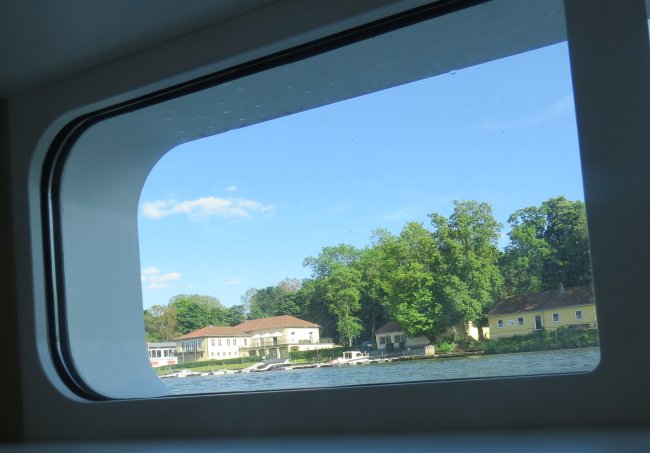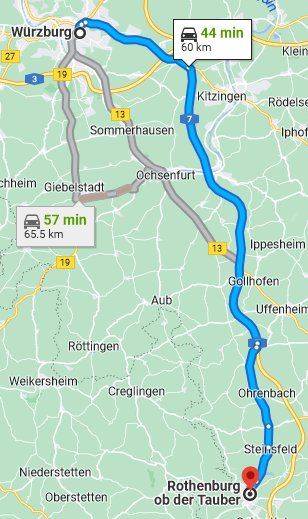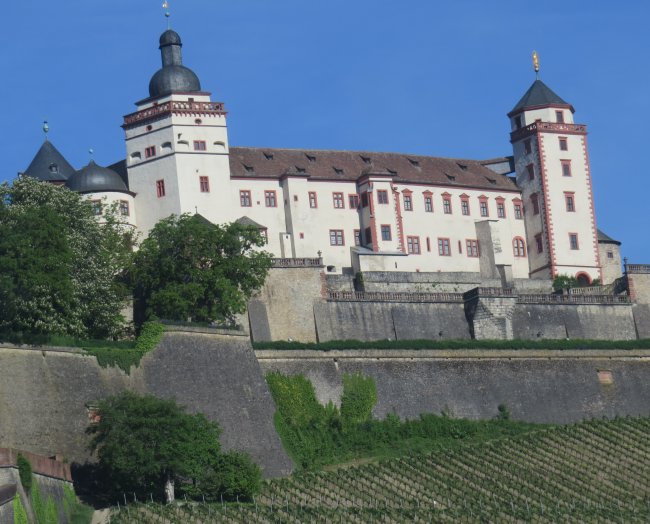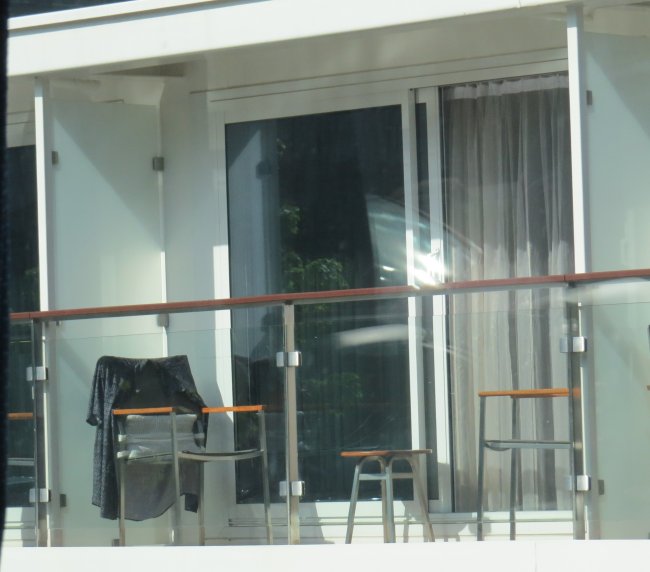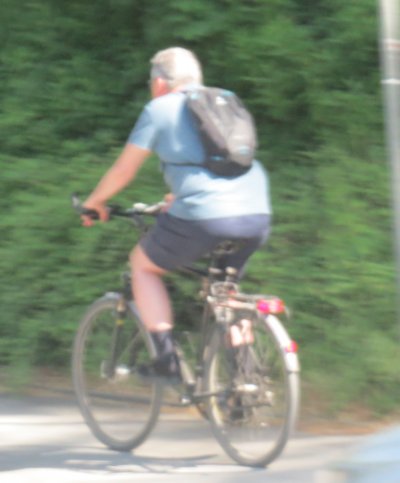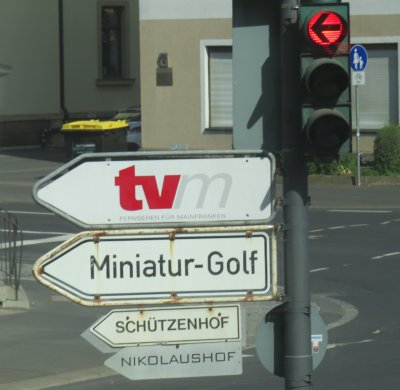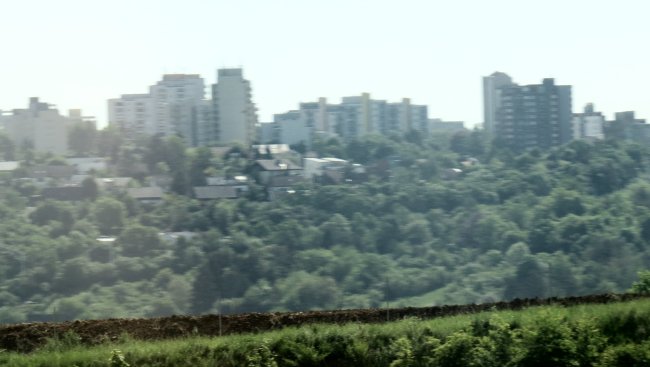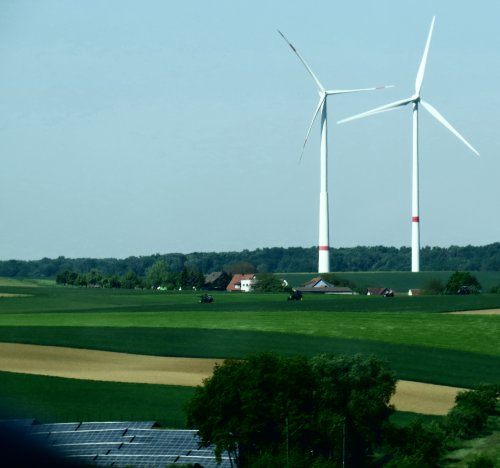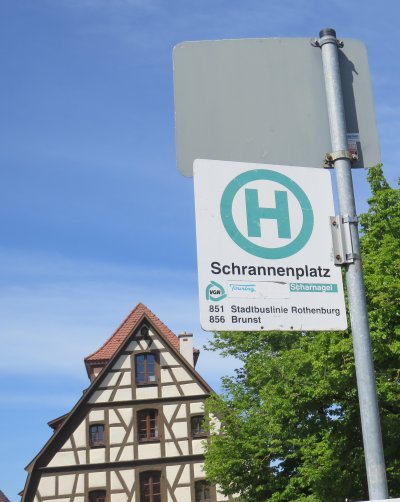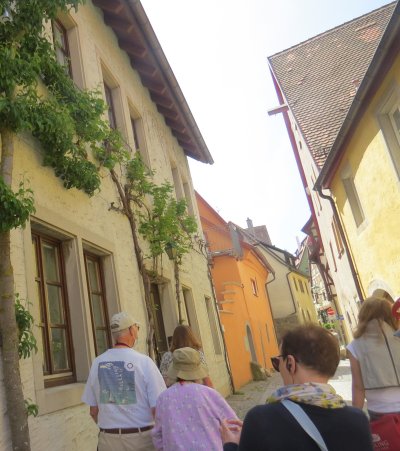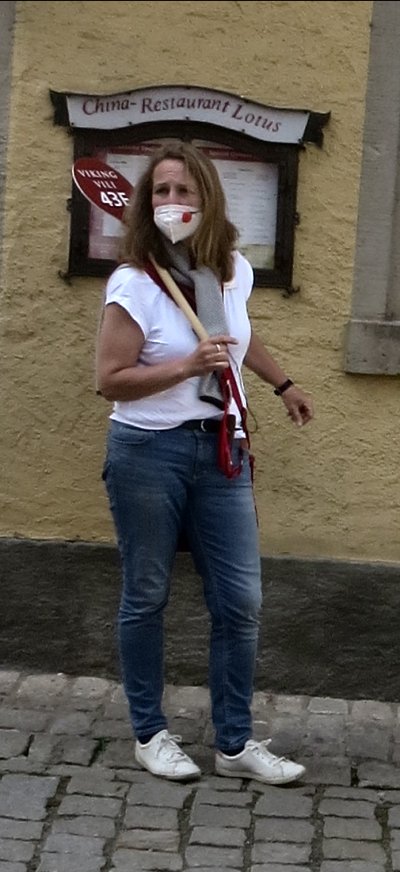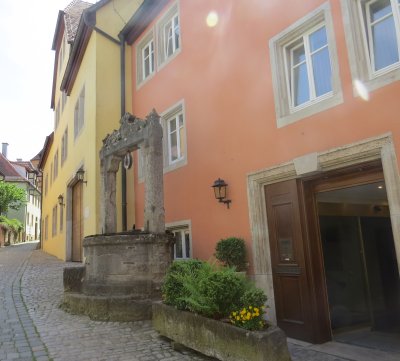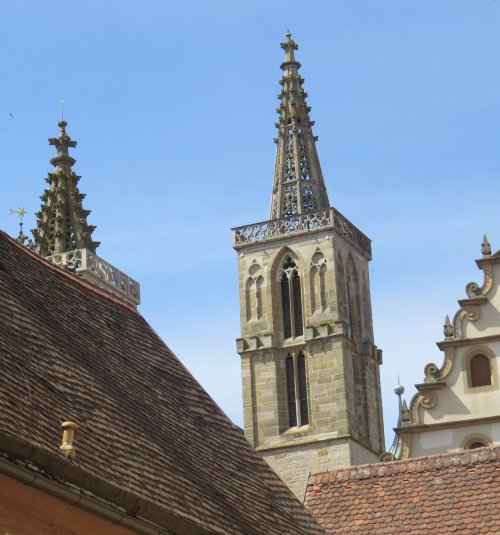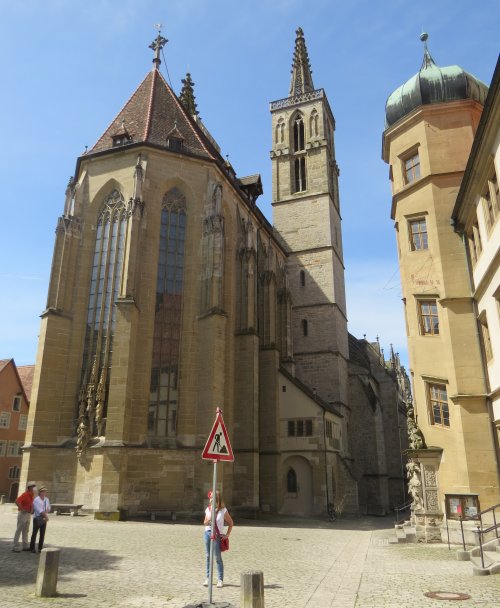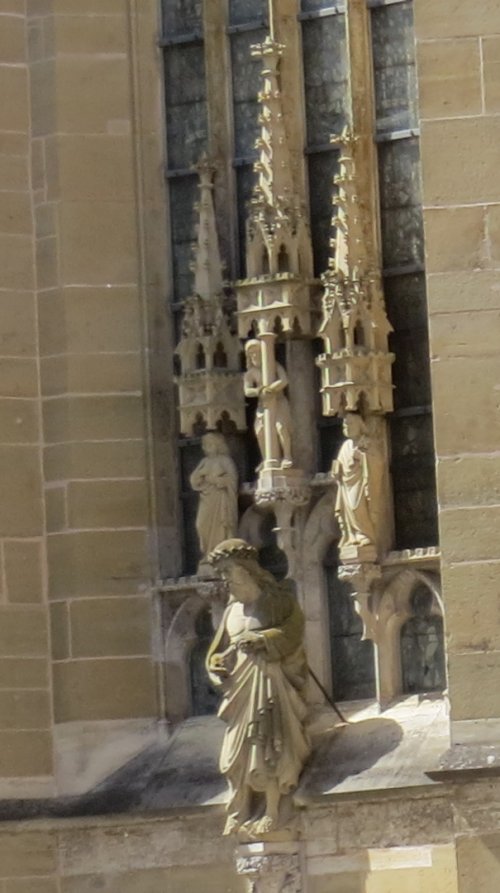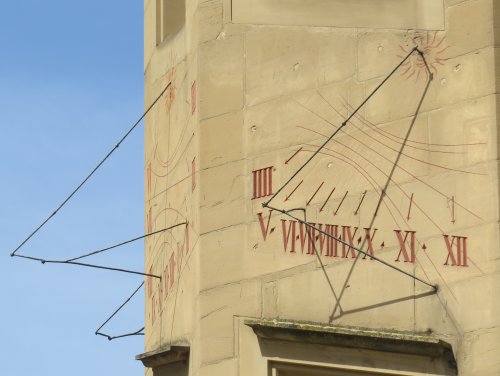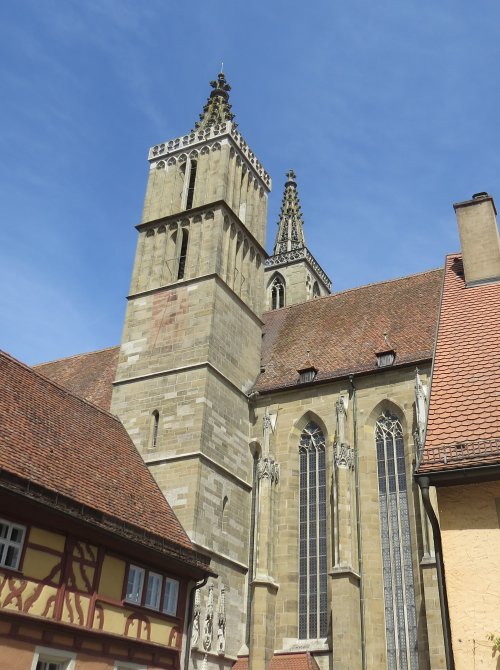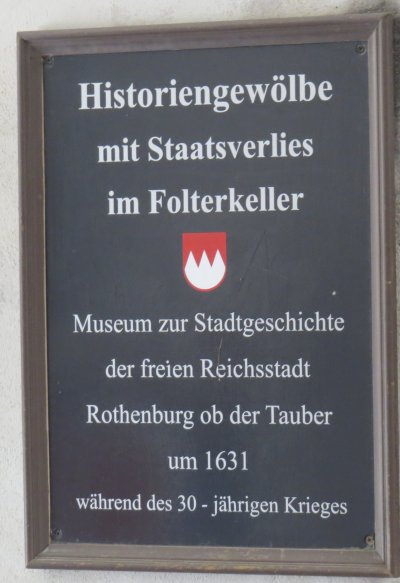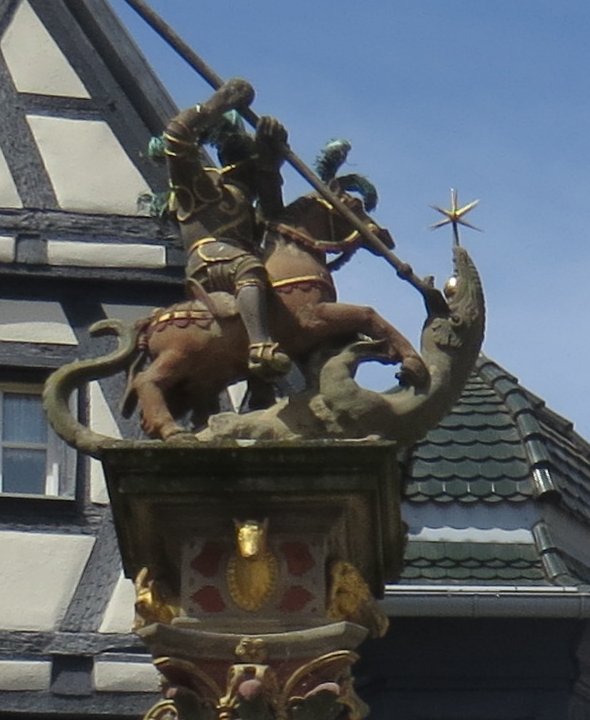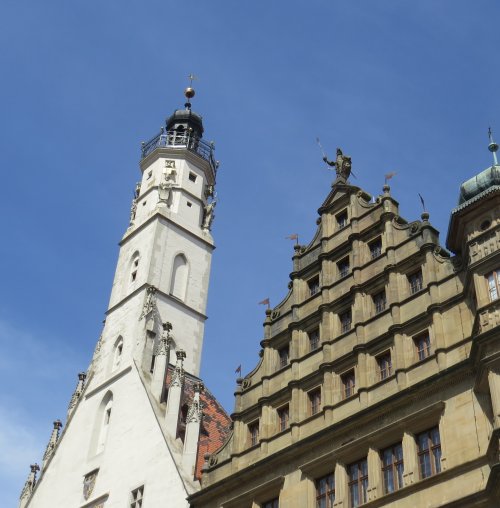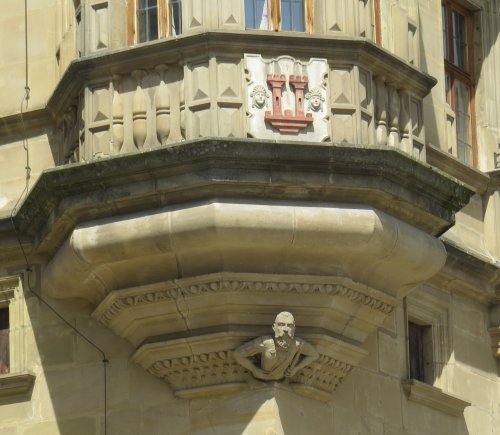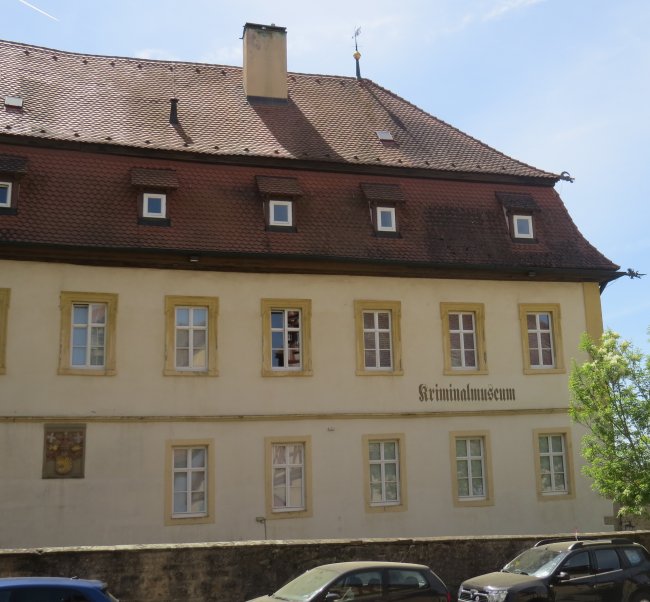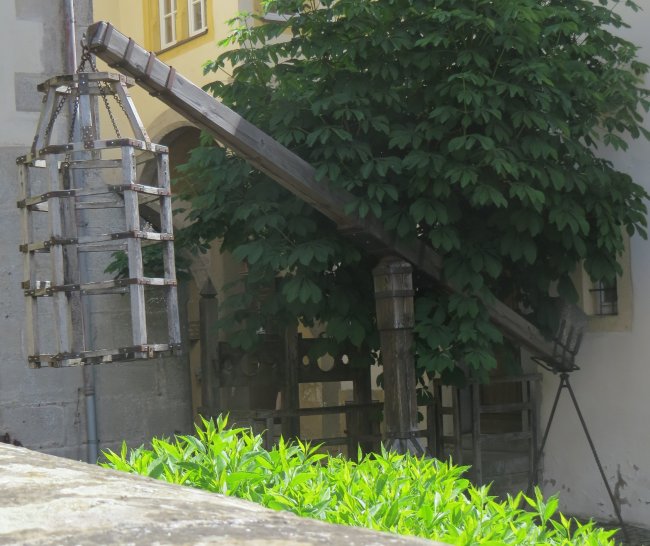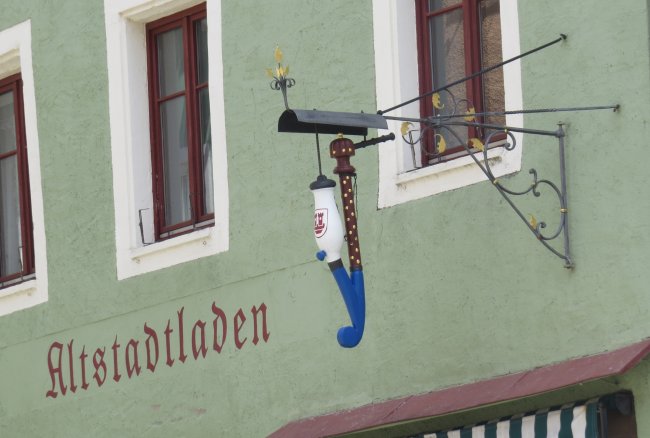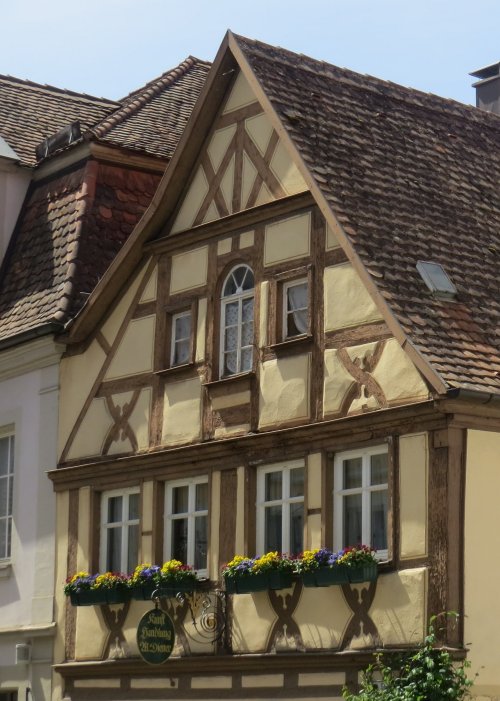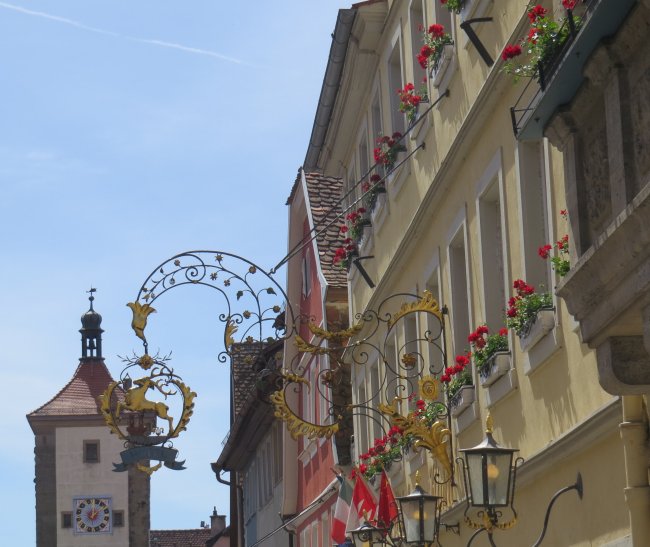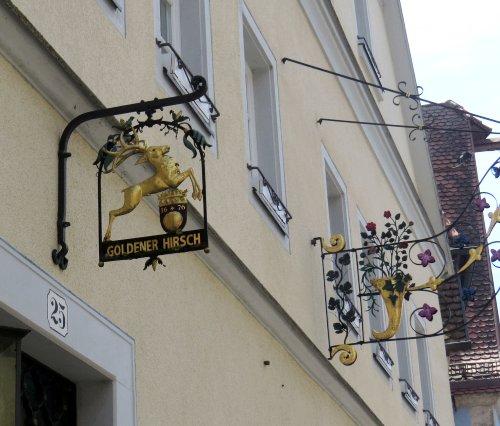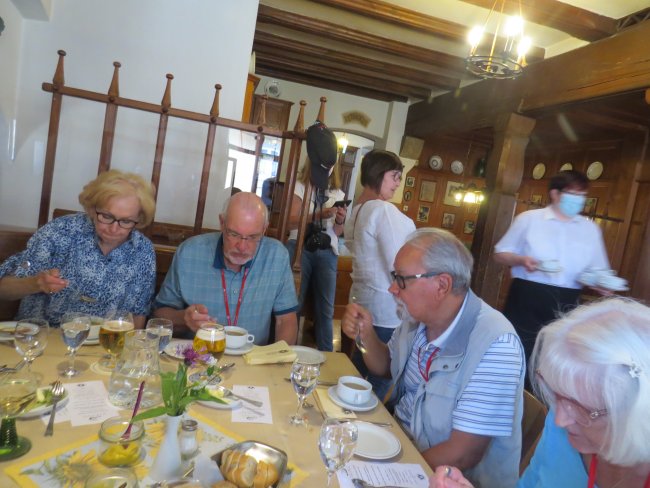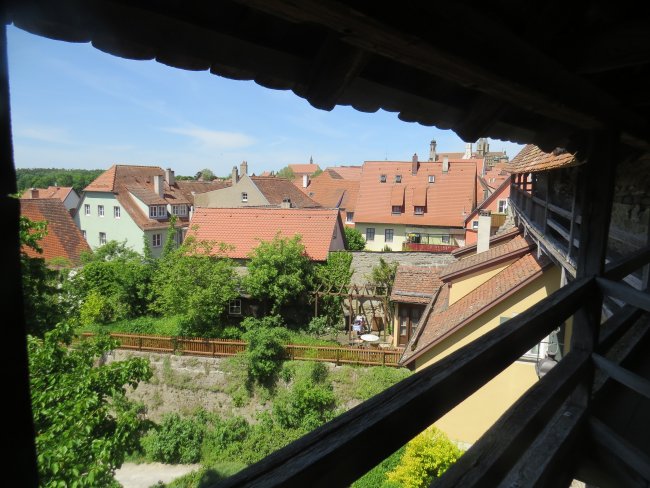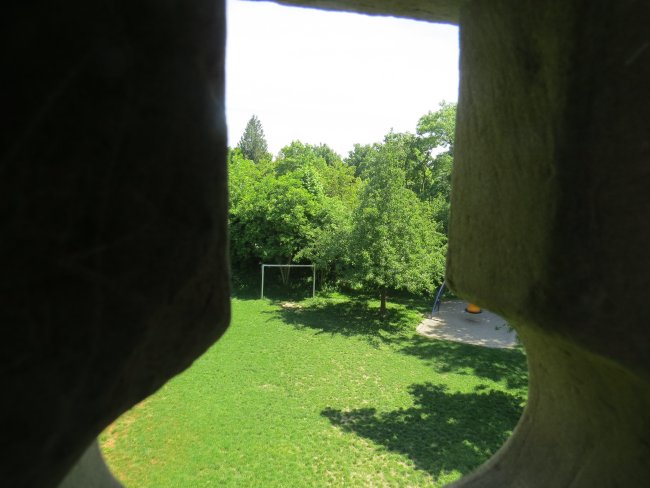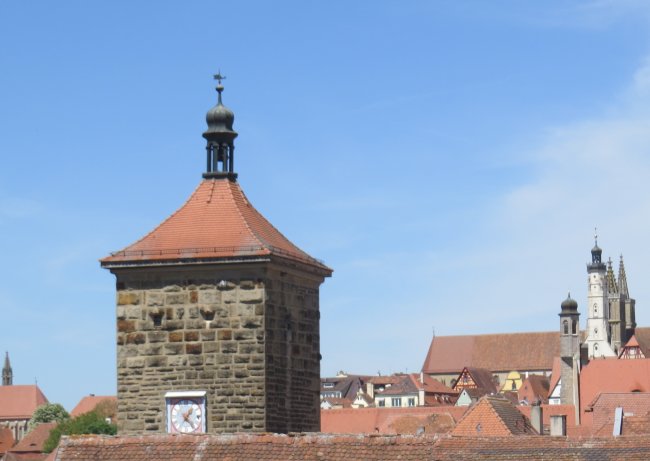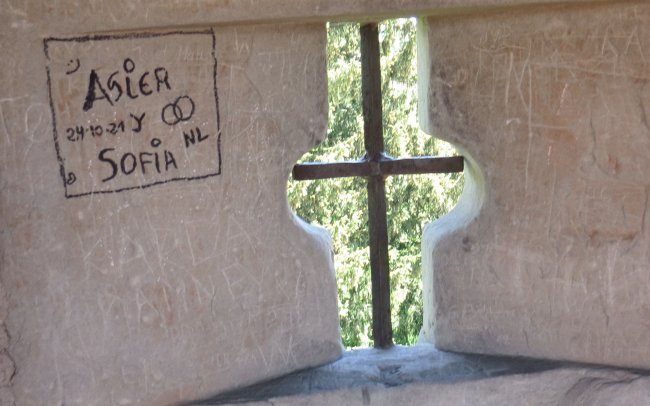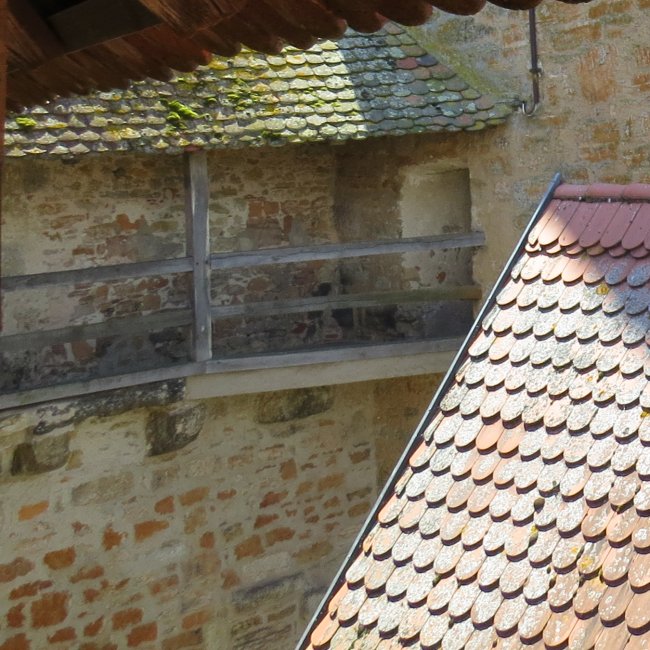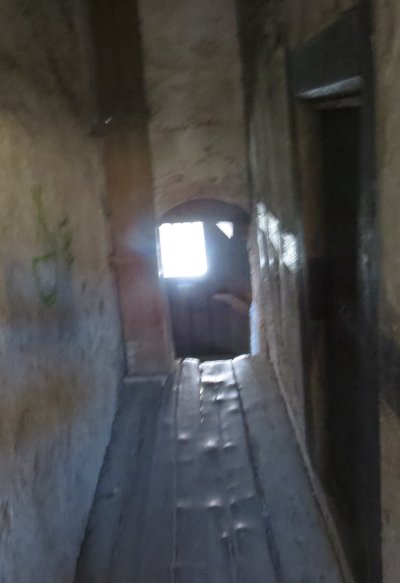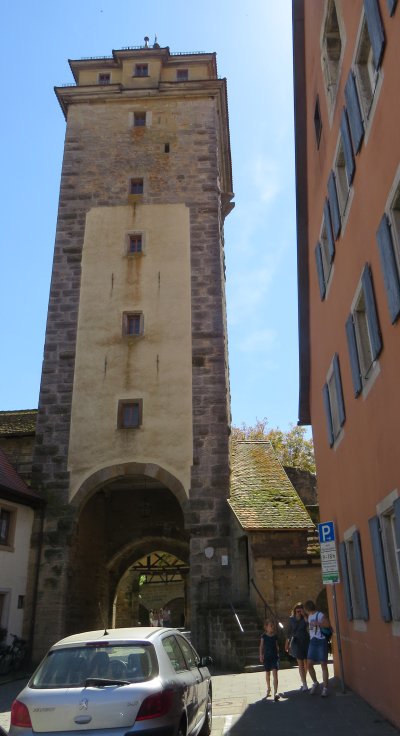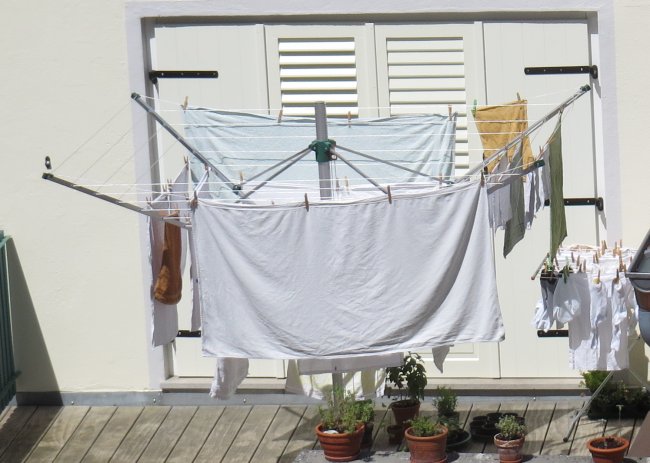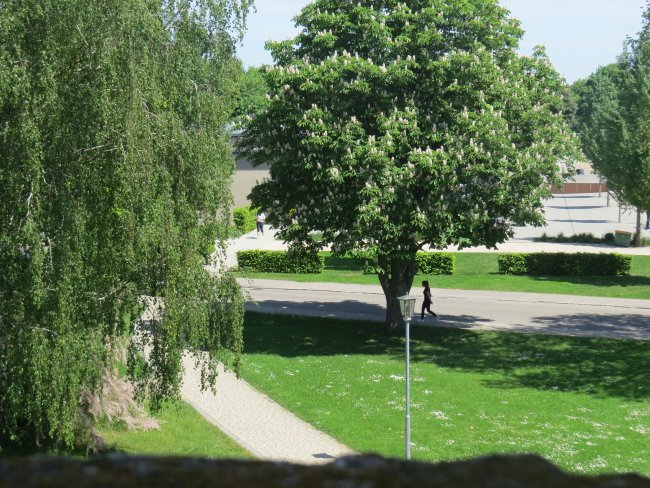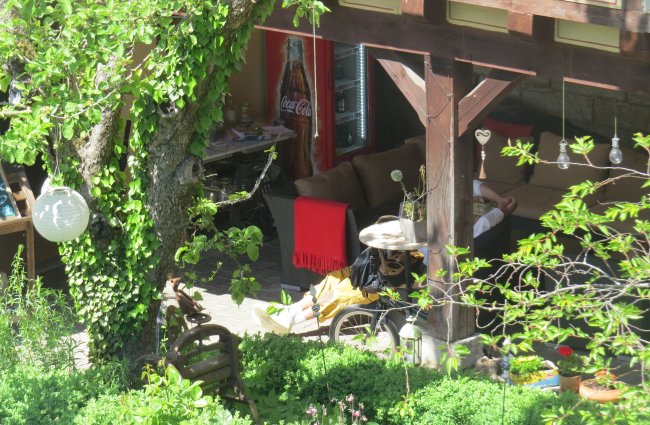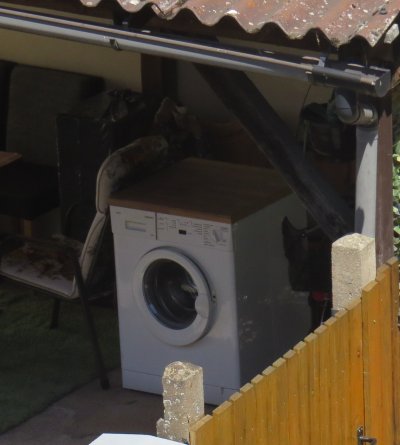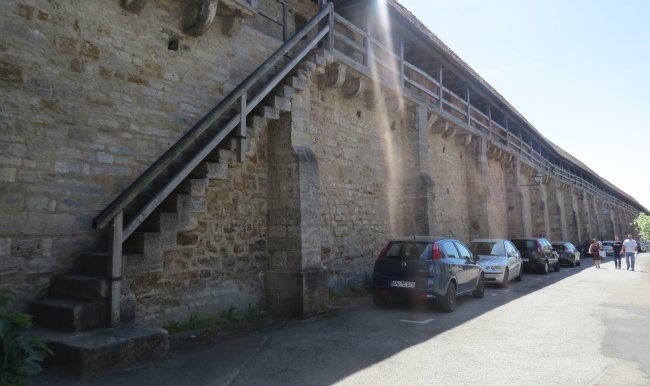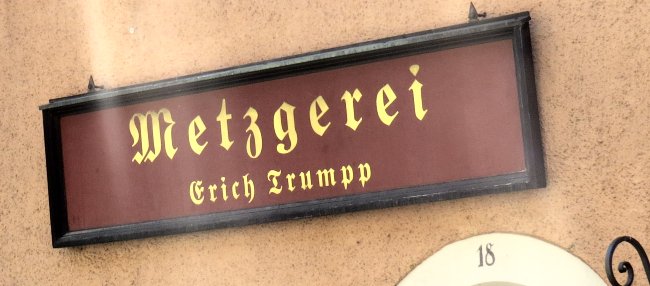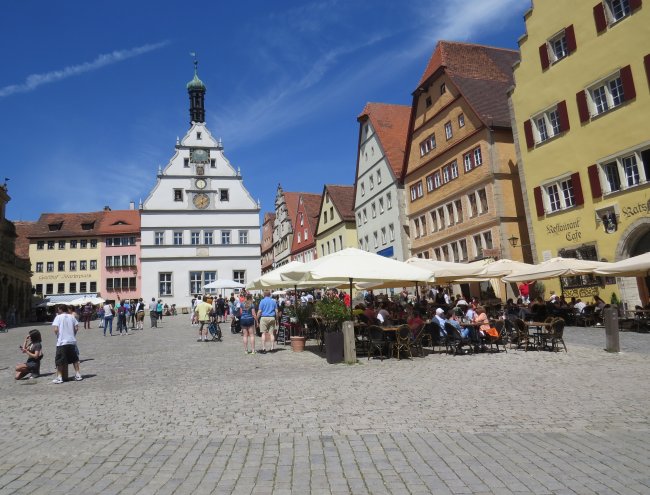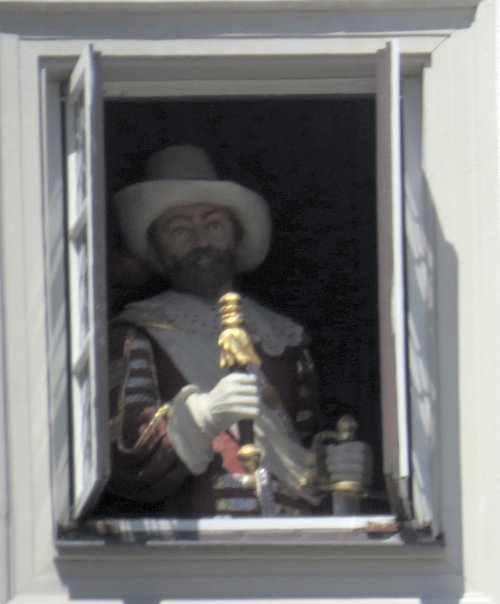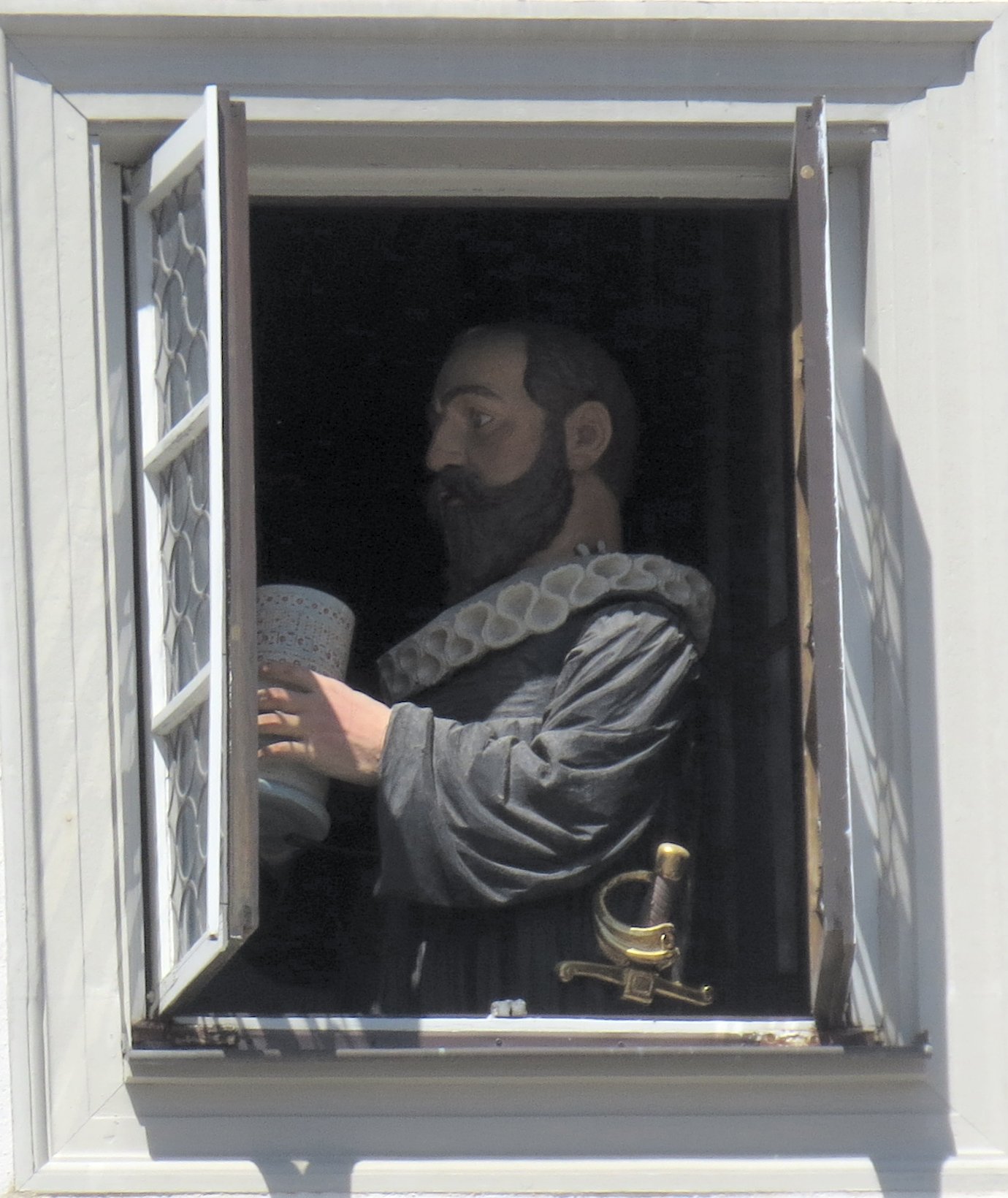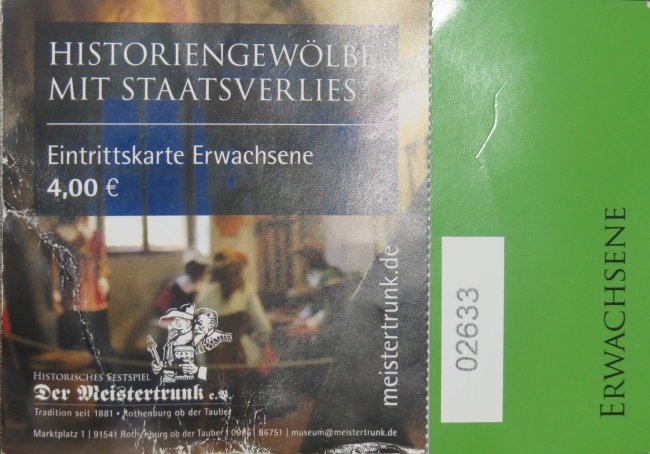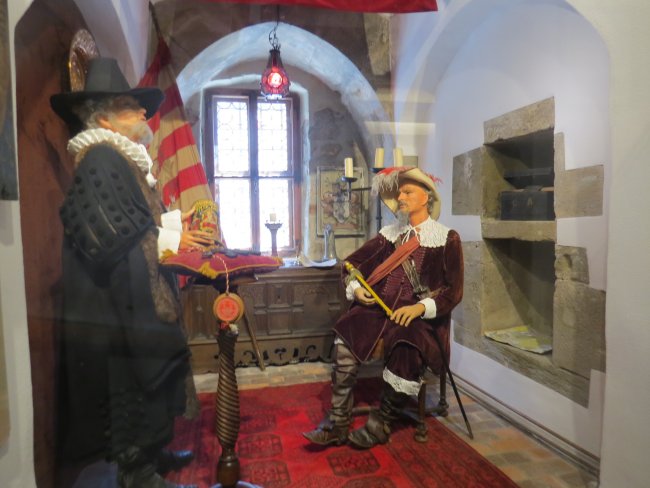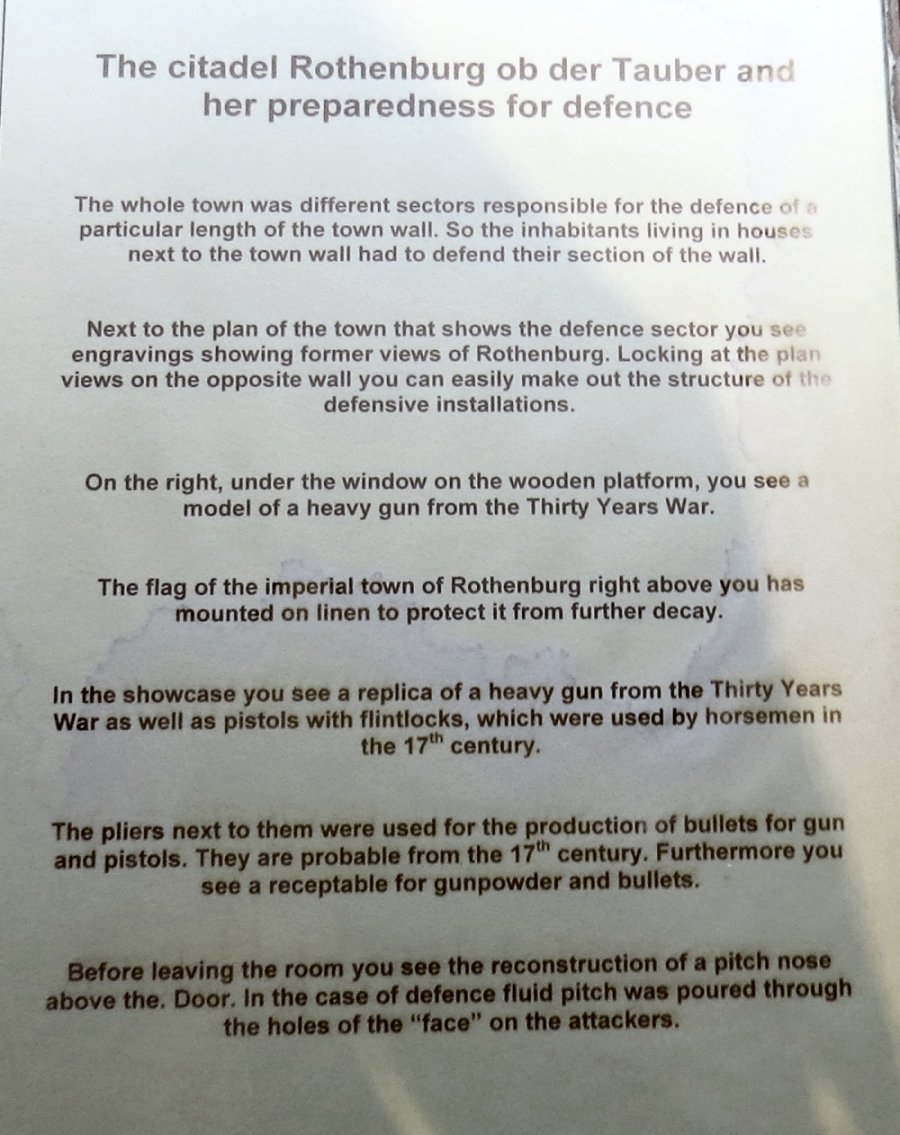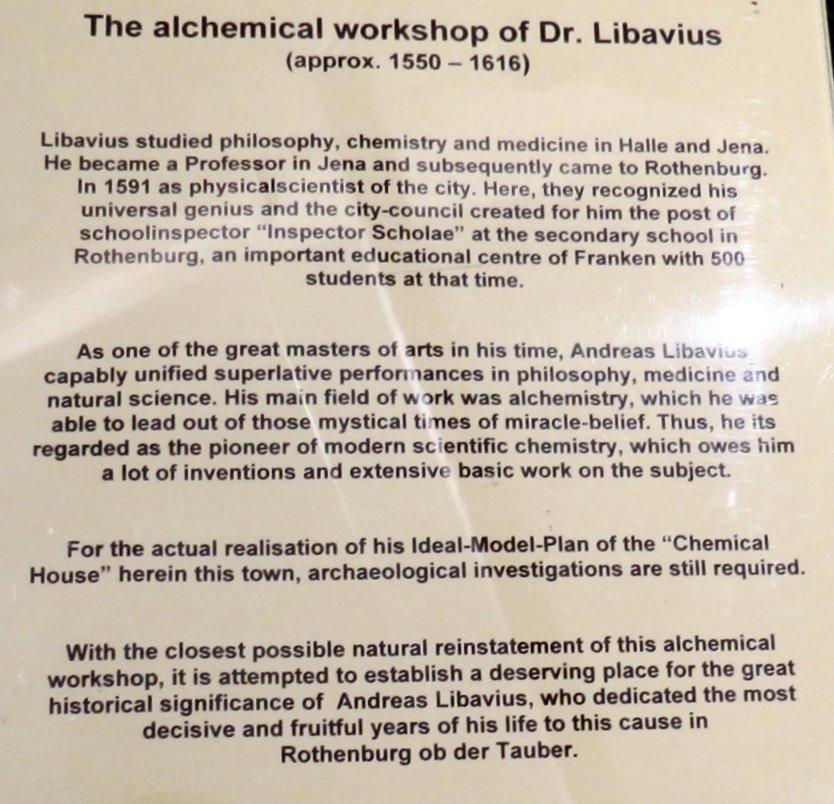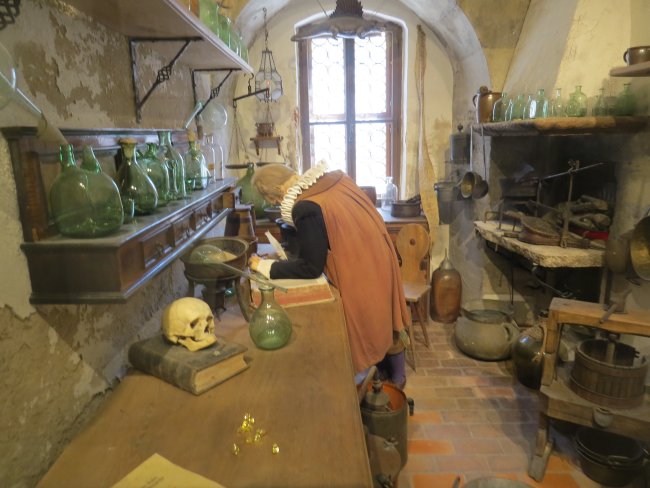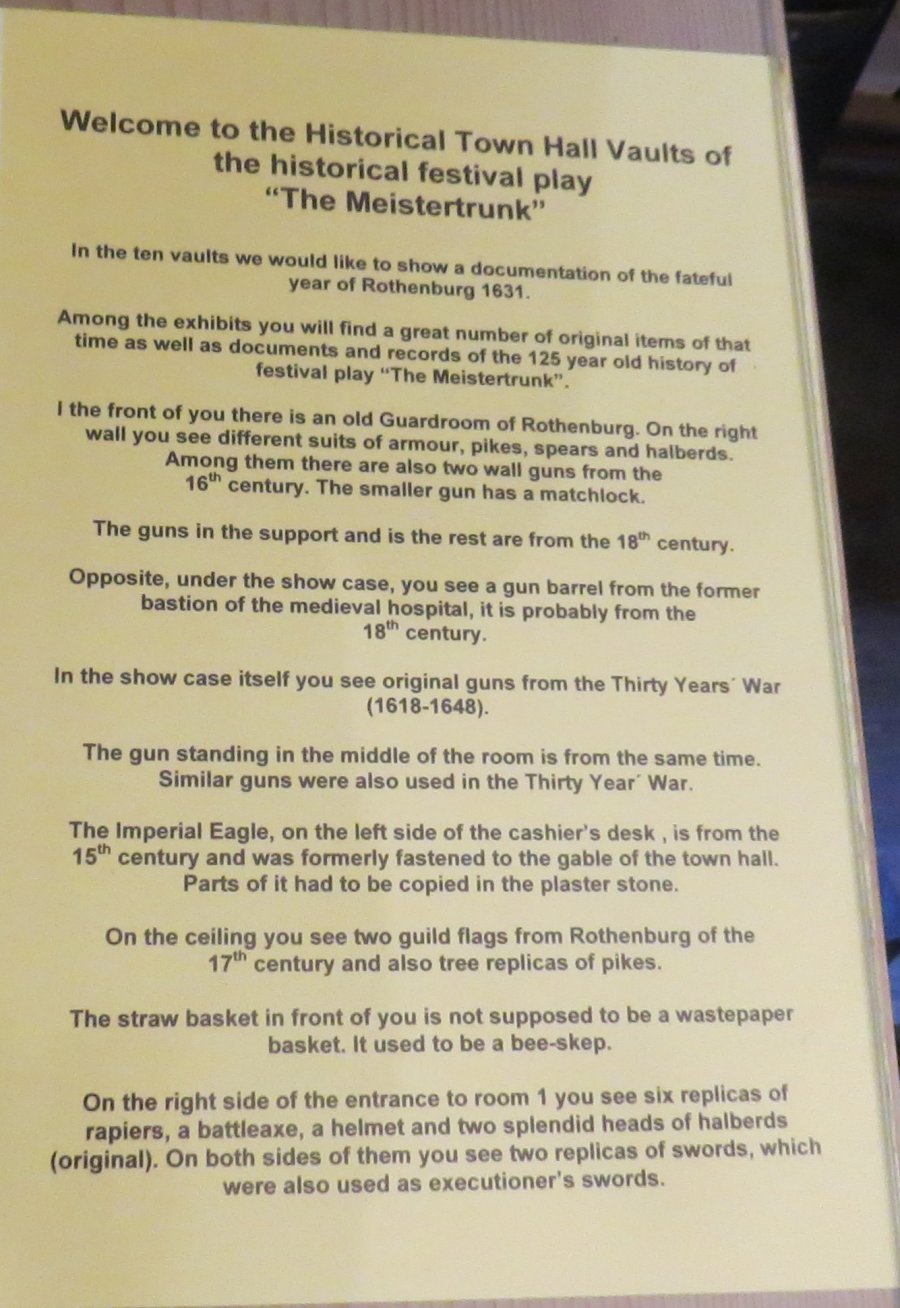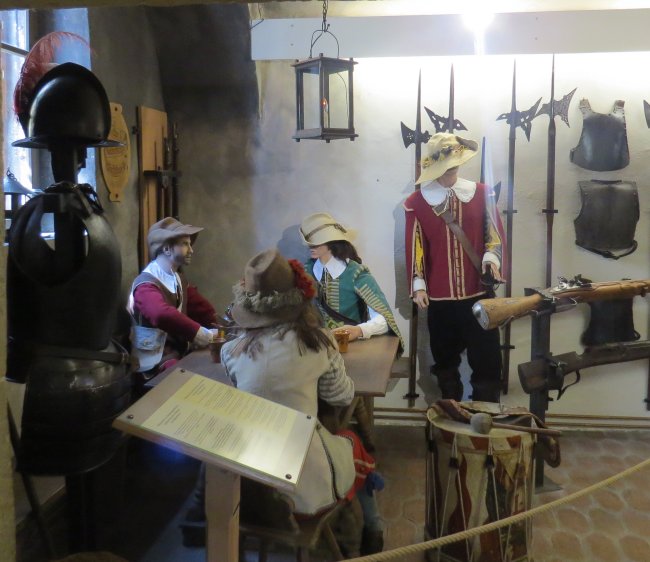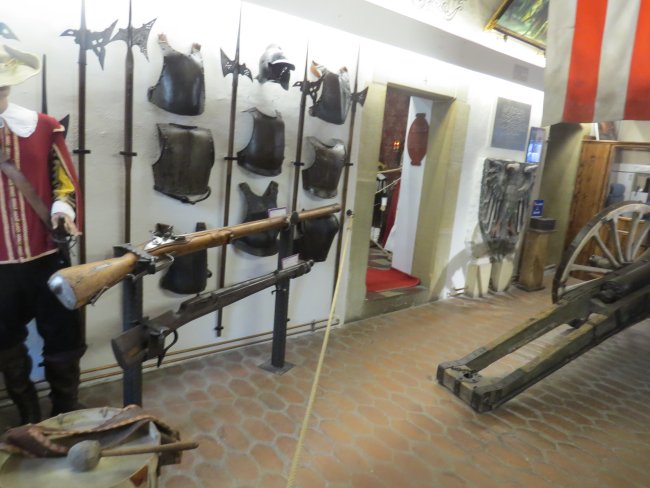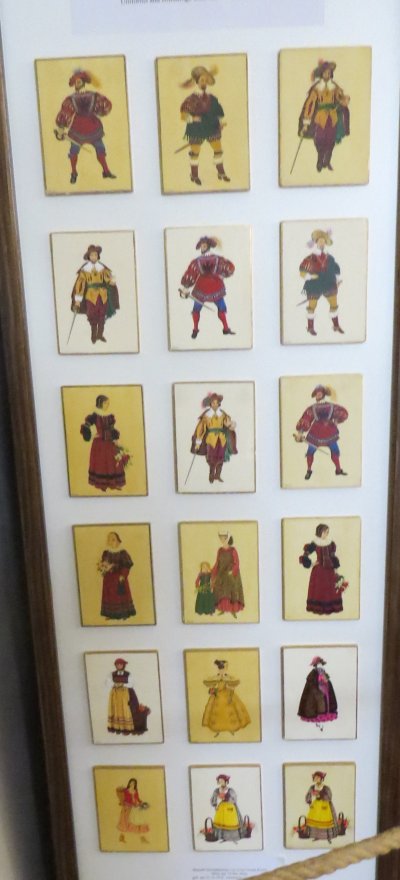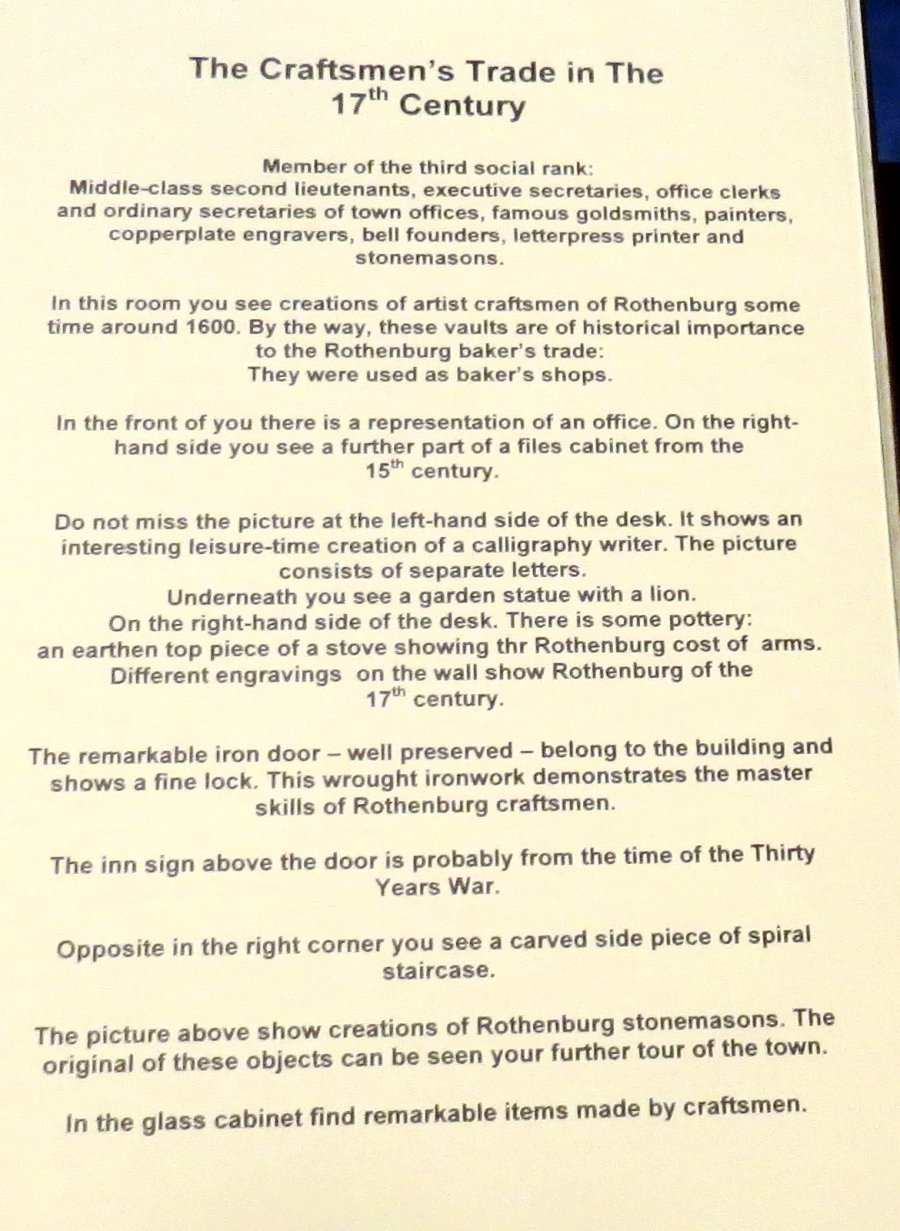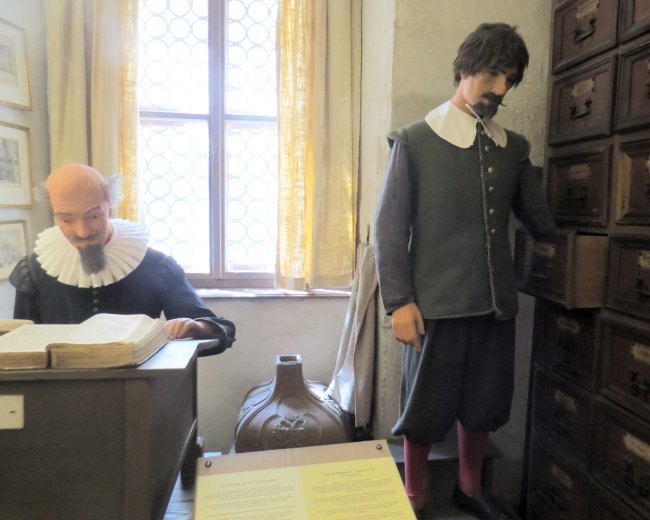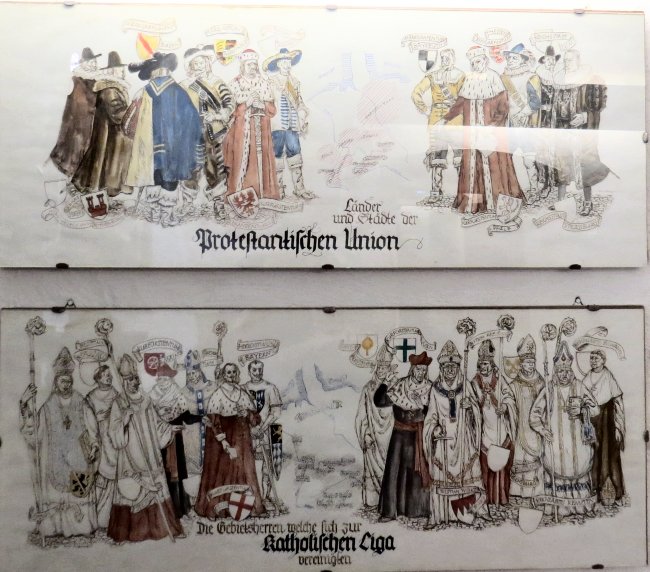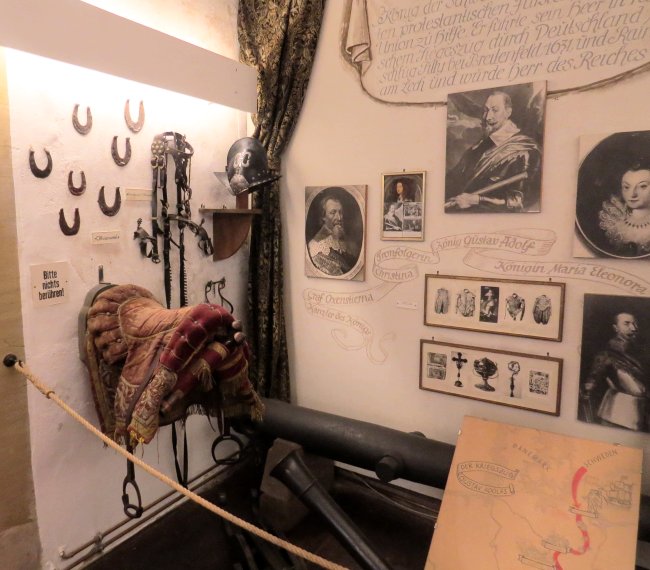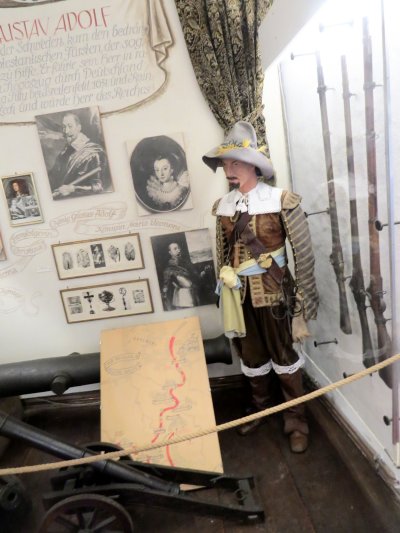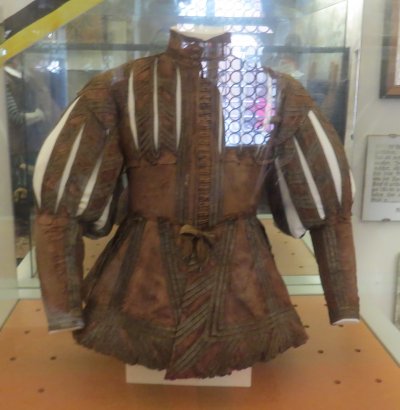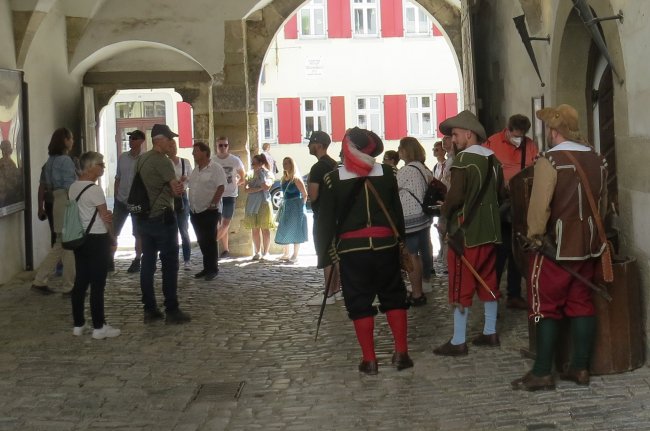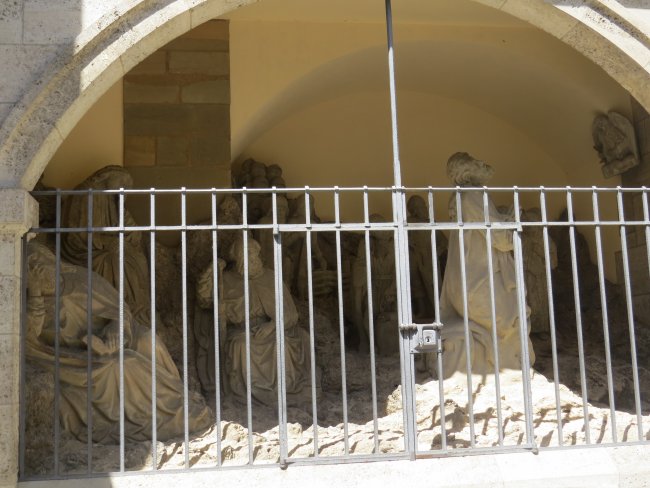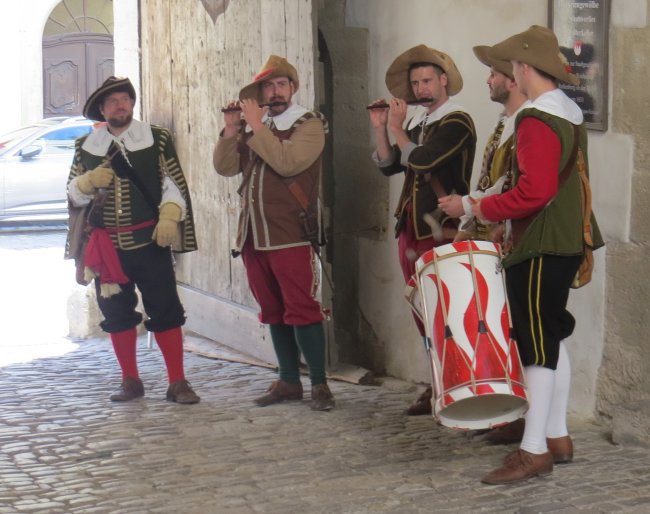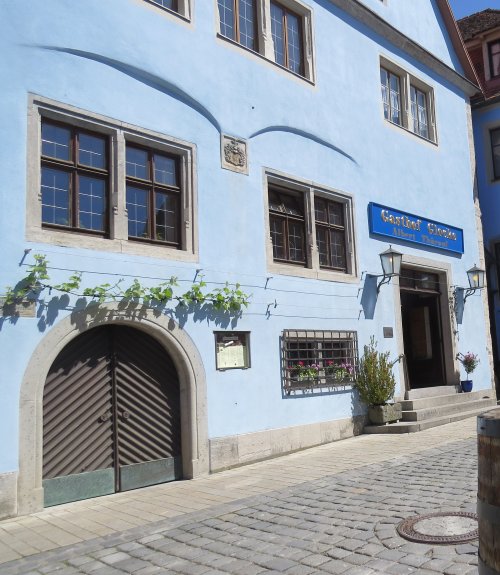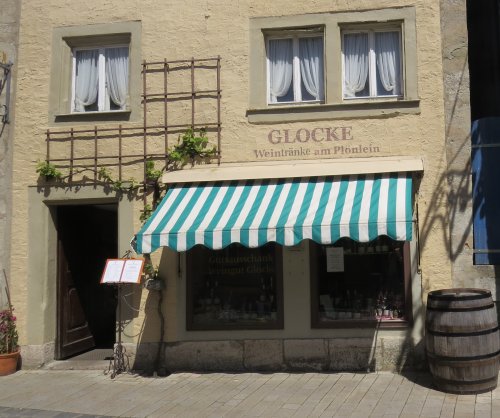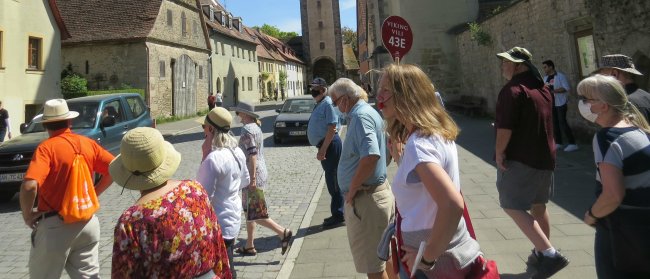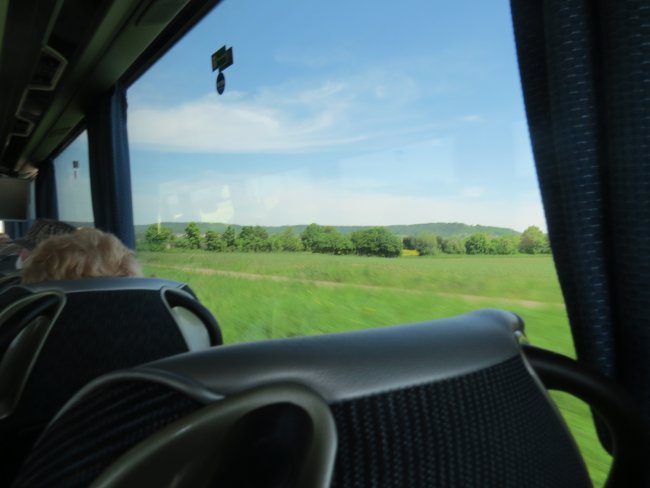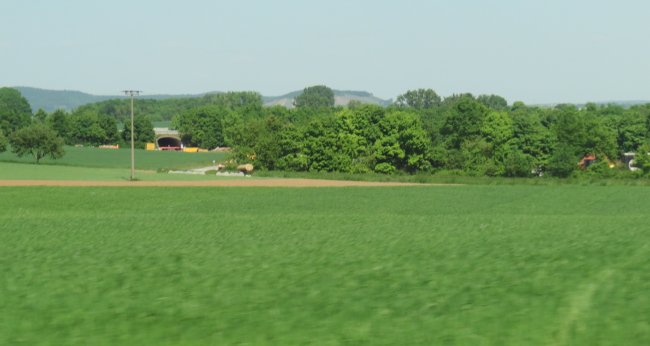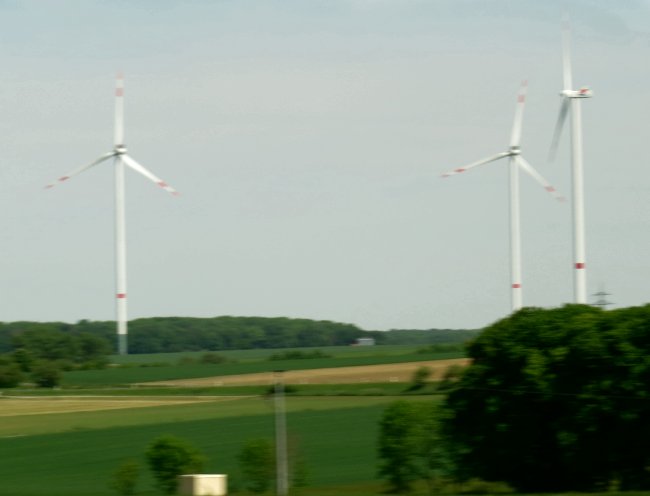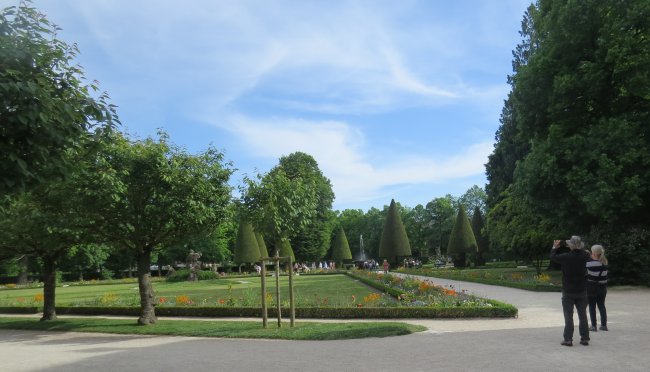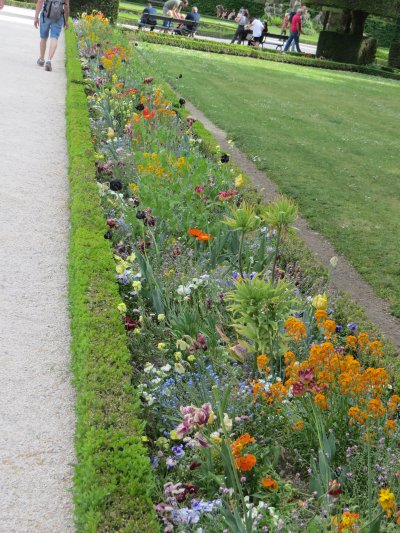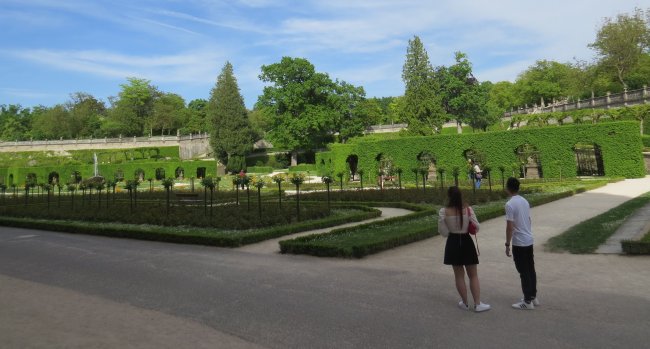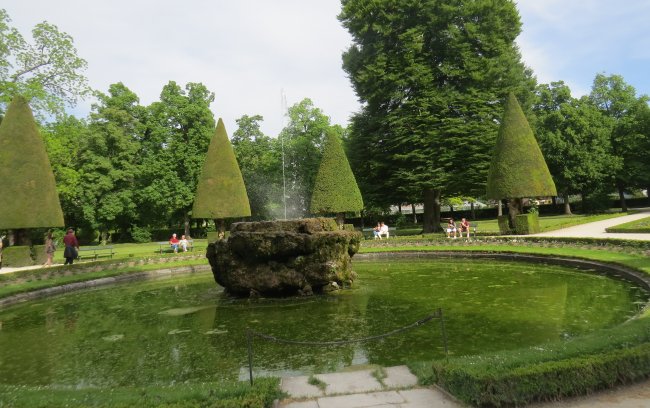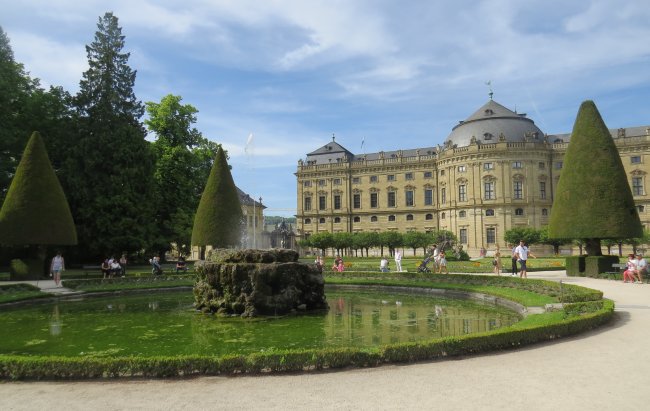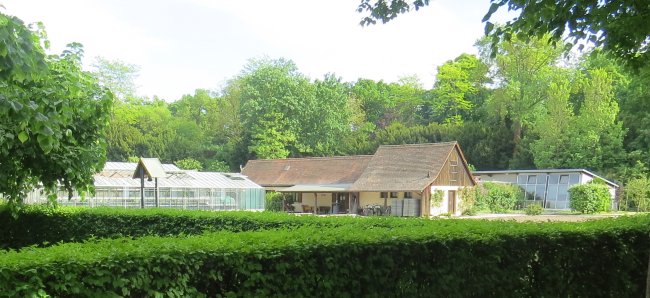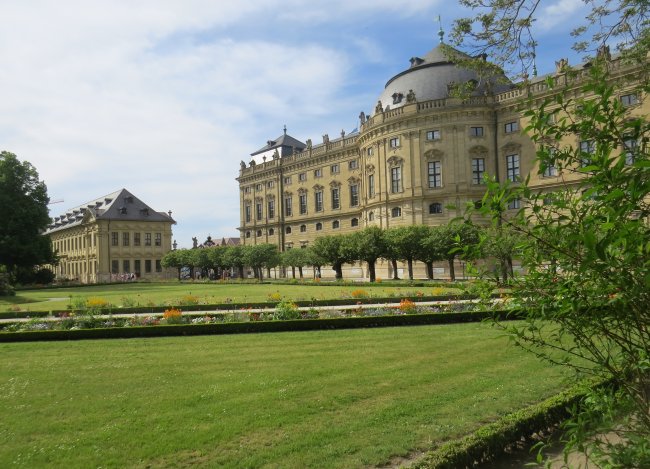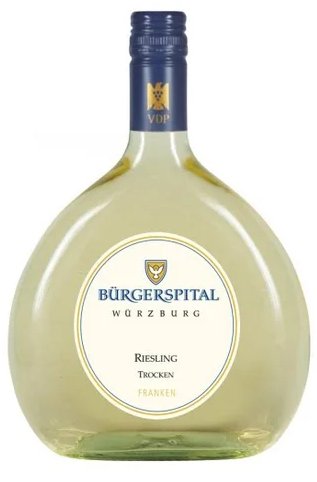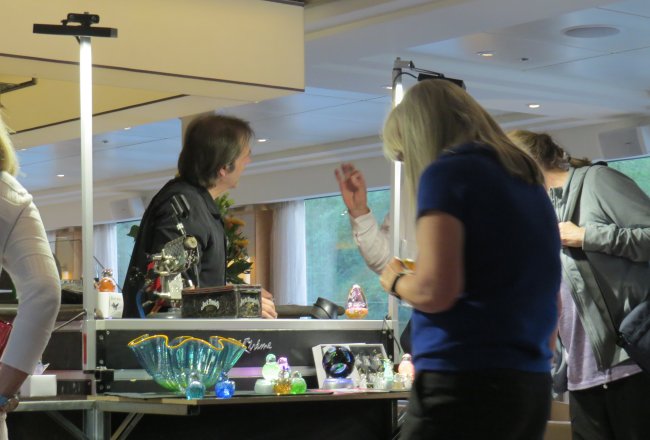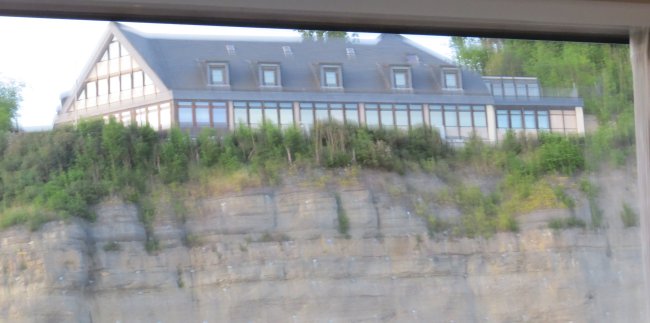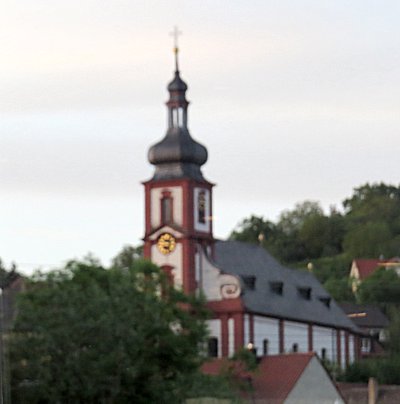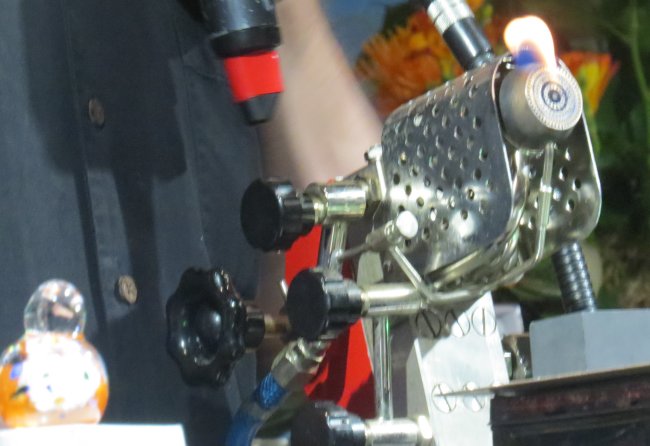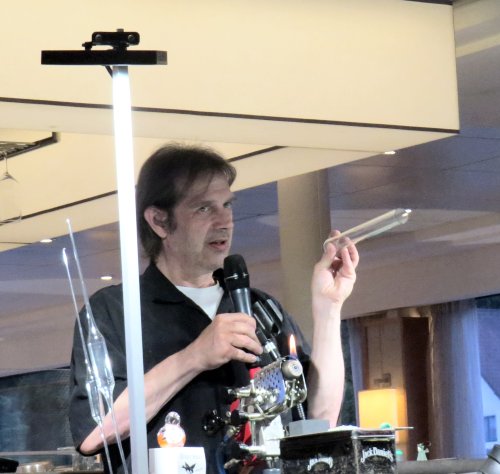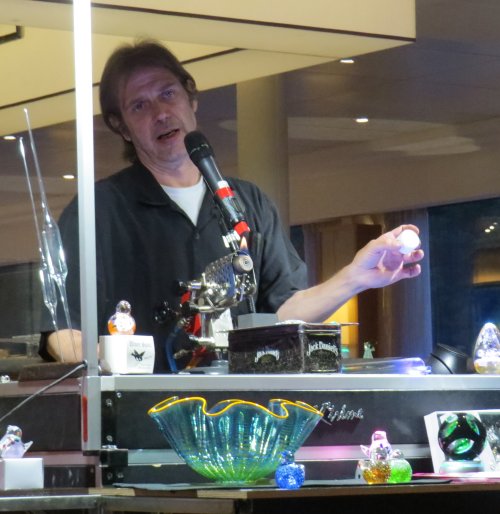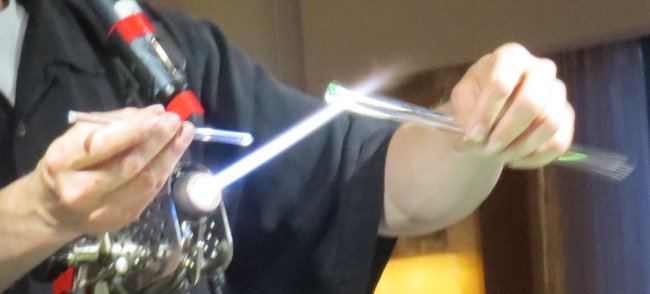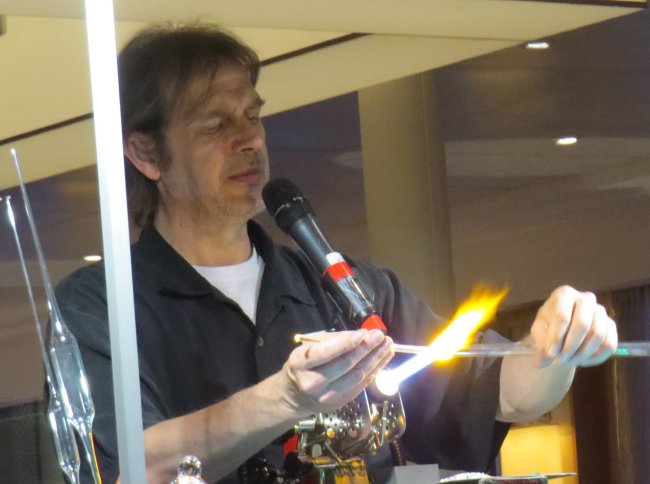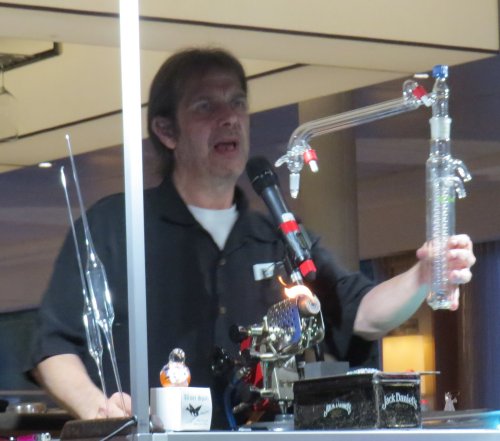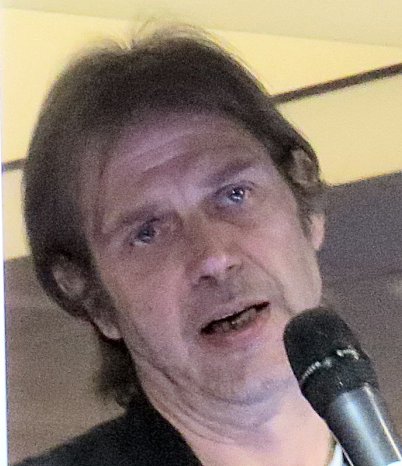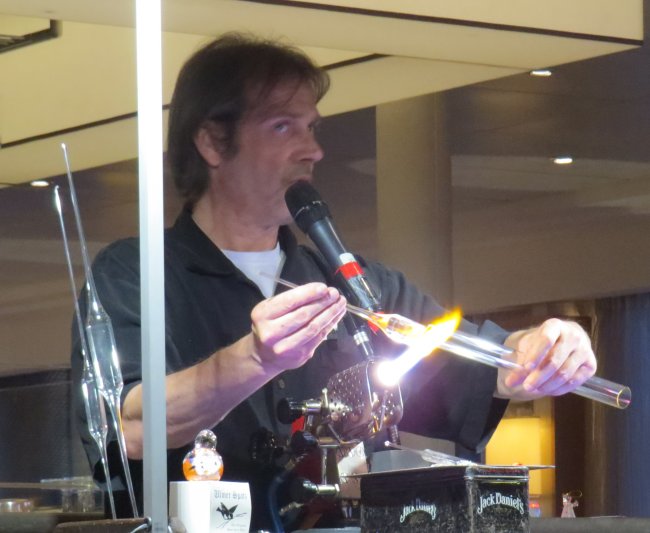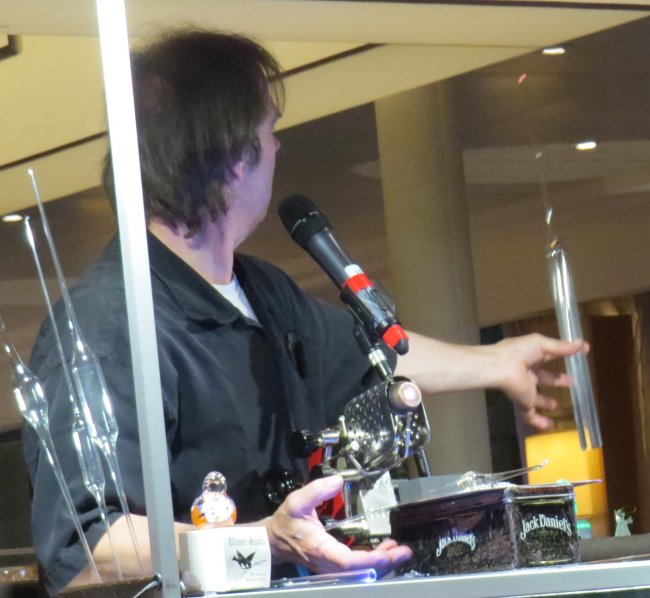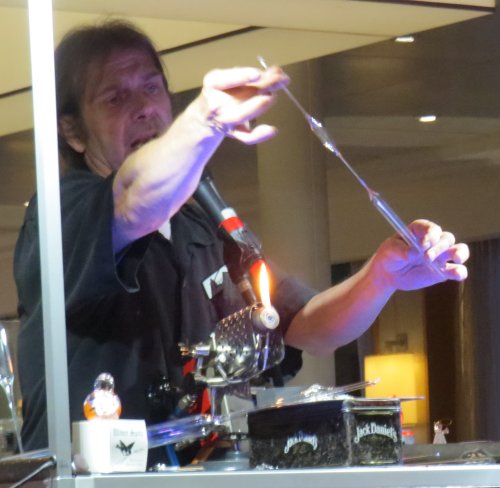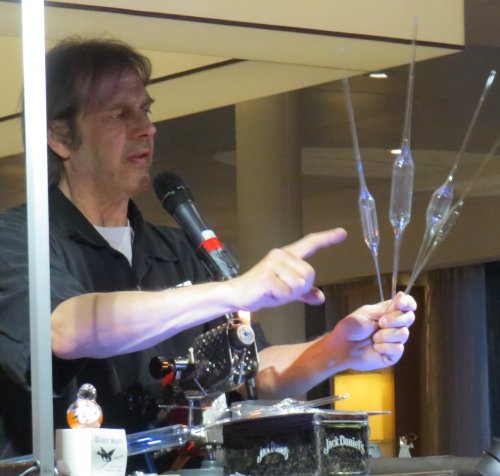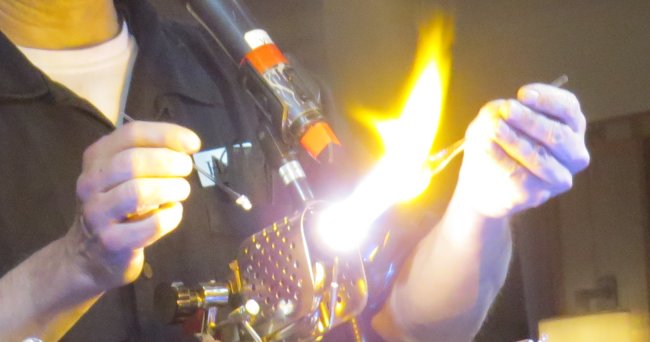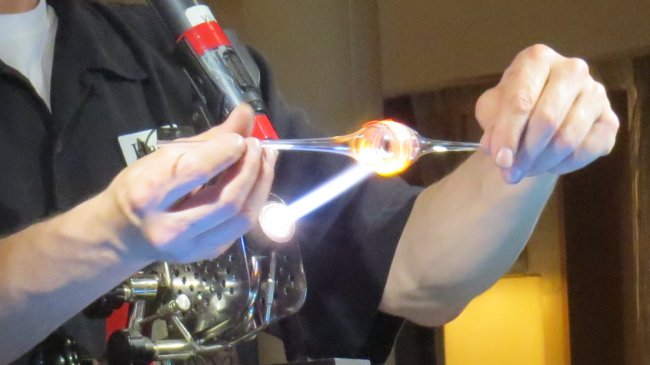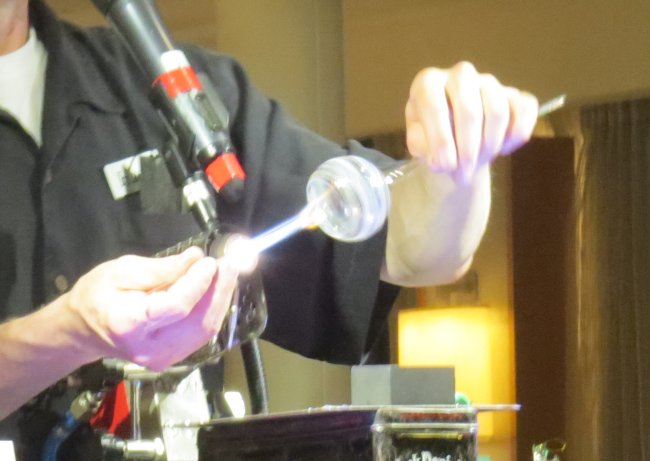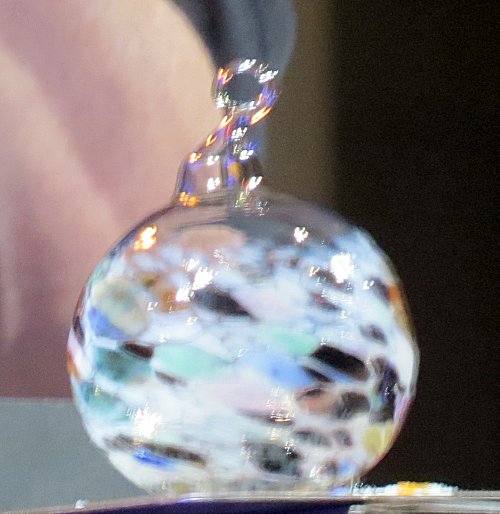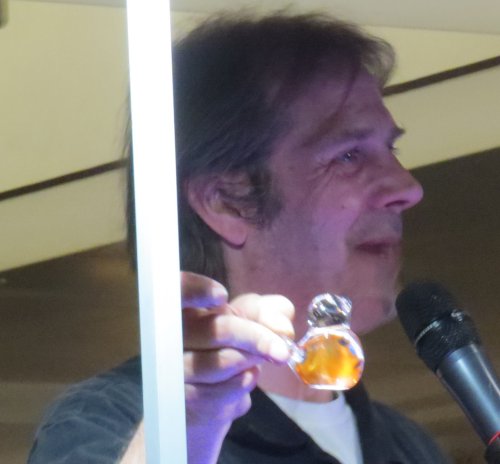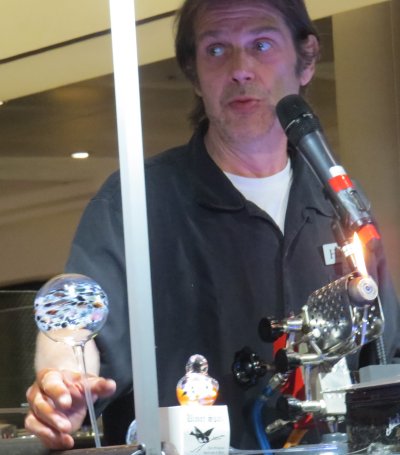Before the excursion: For the first time in Germany all of the excursions were scheduled to start and end in the same place, Würzburg[1]. The Viking Daily said that we would land at 10 a.m. and depart at 6 p.m. Most of the locks must have been behind us.
I ate breakfast alone. The restaurant had far fewer people than usual. Either people were sleeping or they settled for less than the full breakfast. Or—perish the thought—they had been escorted off of the ship.
I sent Sue a long email. Most of it was about my last two days of cruising. I closed with this:
The room is very small. You have to go out to the corridor if you want to change your mind. You were right; I do hate the little bench on which I have to sit, but there are plenty of comfortable places to go on the ship.
I took a photo from my room's window as the ship neared Würzburg.
The bridge tournament was scheduled to start in Marlborough, MA, on Thursday. The CDC rated Middlesex County's infection rate as "High". I wondered if they would enforce wearing of masks at the tournament.
The bus trip to Rothenburg ob der Tauber: :
I finally seemed to have recovered my ability to tour. I remembered to bring both my camera and my recorder, and they both had fresh batteries. Playing back the recording before composing the journal many weeks after the fact was very enlightening. I learned a lot more than I did by just listening on the bus.
The tour guide said that her name was Katrin, and the bus driver's name was Elmar or something like that. She told us that the ride to Rothenburg would be 65-70 minutes. She lived in Würzburg, a city of 130,000 people. There were sixty churches, all but a few of which were Catholic. Roughly 300 wineries were also in the vicinity.
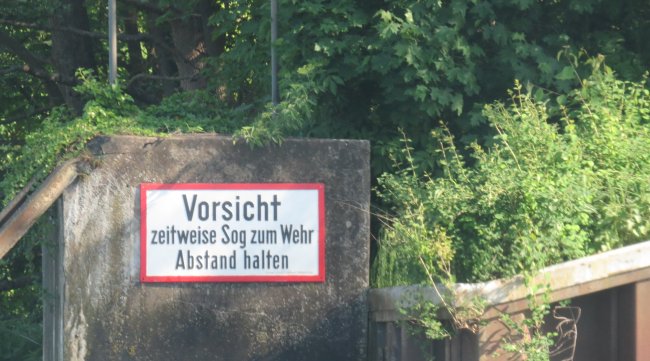
We passed a pilgrimage chapel. Katrin informed us that devout ladies do the Stations of the Cross there (sometimes even on their knees) and finish in the chapel. She then drew our attention to four stone lions that were posted on the corners of a nearby bridge. Only two of the lions were Catholics, she said; they were looking at the chapel. The ones on the other side were Protestants; they turned their back on the chapel.
Katrin, who was a Protestant of some stripe, said that she had been called the Antichrist[2] three times when she was at the university in Trier, but she had not been criticized in Würzburg.
A beautiful fortress surrounded by vineyards appeared on the left. It was over eight hundred years old. For five hundred years each Prince-Bishop had endured life in the fortress, but Prince-Bishop Johann Philipp Franz von Schönborn thought that it lacked a certain something. So, he ordered construction of the splendid baroque Residenz Palace in the 1720's. We would be stopping at the Residenz Palace on our way back from Rothenburg.
Katrin said that Rothenburg[3] was the best preserved medieval (she called it "middle-aged") town in Germany. She also promised us quite a bit of free time after lunch there.
Travel was reportedly dangerous in the Middle Ages because of returning crusaders who followed a new career as wayside robbers.[4] Later they were joined by nobles who charged tolls.
For a short time the bus drove on the A3, which was legendary for always being under construction. Then Elmar turned onto more rural roads. We learned that the cost of a driver's license in Germany was €2,000, and it was easy for one to lose one's license for violations. Speed limits were enforced in some sections of the autobahns.
Different types of grains were grown in the surrounding fields. Katrin identified the yellow flowers as rapeseed; she called Canola a brand name. Sugar beets were also grown here. In the fall the sugar refineries were operating, and the smell was sour and disgusting. It also penetrated and lingered in cars, clothing, etc. Farming was subsidized in the European Union. Many farmers have second or even third jobs. "Moonlight farmers" worked on their fields during the night and on weekends. We passed some stalls where people were selling asparagus and strawberries.
The Peasants' War began in 1525. The "ringleader" was Flovian Geyer, a nobleman from Giegelstatt, which was on our route. The discontented peasants met at an inn in Würzburg to plot. They hung a mace (a club with spikes) to tell supporters that they were there. The peasants tried to take the fortress in which the Prince-Bishop lived, but they failed miserably. "A stream of blood was pouring down the hill." The peasants did not become "free people" until the middle of the nineteenth century. There were many ruins in southern Germany from the Peasants' War.
Franconian farmhouses have long had three buildings arranged in a consistent configuration. The main building sat with the narrow side facing the street. The kitchen, which was up front, was the only room that was heated. The living room was in the rear, and it was only used for special occasions. Bedrooms were on the second floor.
The stable was parallel to the street. The third building was the barn, which was later used for storage of machinery. The buildings were close to the street with a big gate. They looked like small forts. I was not able to get a photograph of one.
The Franks came to this area about 1500 years ago in a great migration. The lazy ones stayed in Germany. The aggressive ones moved into France and formed the duchy of Western Franconia. French and German Franconians both enjoy life and especially wine.
The wooden huts on stilts were used by people who hunted deer, pheasants, and especially wild boar. The boars were a menace to the fields of the farmers.
We passed a farm that had covered all of its fields with solar panels. Katrin said that many homes had recently installed solar panels on their roofs, but more in the north than in southern Germany.
We turned onto the "Romantic Road", which started in Würzburg and ended in Füssen in the foothills of the Alps. The name didn't refer to romance but to the romantic movement in music, art, philosophy, and literature of the late nineteenth century. Many practitioners of these arts settled in the villages of Bavaria to isolate themselves from the industrial revolution. We can thank them for Rothenburg, which had become very poor after the Thirty Years War. Many residents had abandoned the town. The Romanticists migrated to Rothenburg and instituted laws so that the town could not be significantly changed.
We reached the Tauber river, which was named by the Celts ("the Dark One"). In many places it was hidden by willows. Germans called it the "Lovely Tauber valley".[5] The bright blue flowers were wild sage. We passed a number of apple trees and cherry trees. We saw very few people because it was Sunday morning, and people were either at church or relaxing.

Near a village on the Tauber we passed the vineyards operated by the owners of the restaurant in which we would have lunch. They produced two varieties of white wine, one dry and a fruitier variety that they recommended for our lunch. They planned to serve us potato soup and "Lutheran" bratwurst, which was supposed to be less greasy and contain more herbs, with mustard, sauerkraut, and mashed potatoes. Dessert would be apple strudel containing nuts and raisins and covered with vanilla sauce. "This will be yummy."
Elmar pulled the bus into the parking lot. Our journey ended right on time with a break for use of the restrooms.

The walking tour of Rothenburg ob der Tauber: : Katrin used the QuietVoxes for this part of the excursion. So, I must rely on my memory prodded by reviewing the 134 photos that I snapped before we all boarded the bus again to return to Würzburg.
Schranenplatz, where the bus let us off, was formerly a Jewish cemetery. The Lutheran cemetery was also nearby
The town was easily walkable. It was less than than half a mile across and down, with two very narrow appendages.
The streets were rather empty when we arrived, but they got more crowded as the day passed.
The church named after St. Jakob (James) was part of a pilgrimage route to Santiago de Compostela.
Katrin told us how the clock in the middle photograph above commemorated the time when Count Lilly kept his bargain not to sack the town if the mayor was able to drink the huge tank of wine that the mayor had presented him as a peace offering. I was able to photograph part of the show after walking the wall.
Five minutes after I took the middle photo above the church bells began to toll.
The Glocke restaurant was located just north of the narrow southern part of the walled town near the white circles that contain X and N on the above map.
The food was as advertised, and it was indeed yummy. Incidentally, bratwurst is not a particular sausage recipe; every town has its own variety. The "brat" part means that it is roasted, fried, or grilled as opposed to boiled.
Unlike the excursion to Salzburg, plenty of time was allotted for private exploration. I decided to start by walking around the city wall, an experience that I had enjoyed in Lucca and Rhodes.
Walking the top of the wall in Rothenburg: When I left the restaurant I made my way east to the stairway that was closest to the restaurant. The unique feature of the wall around Rothenburg is that has a roof.
I elected to head south.
The walkway on the top of the wall was maintained very well. However, the views back into the town were disappointing. For the most part all one could see were red roofs.
I came down from the wall at Spitalhof, the southernmost point. My original plan had been to walk the entire wall, but, if the map was accurate, there were no more staircases until the northeast corner, which was quite a long way away. After a few minutes in that southern region I decided to climb back up and walk back the way that I came.
On the second part of my journey I encountered a few other explorers, including my friends from Saskatchewan.
Atlas Obscura posted an article on the Ratstrinkstube Clock Tower. You can read it here.
I had enough time to visit at least one museum. I was not really that interested in torture. I chose to pay a visit to Historengewölbe mit Staatsverlies the entrance to which I had noticed during the walking tour.
The Town History Museum: I bought my ticket for only €4. There was no sign that photography was prohibited. There were no lines; in fact there was almost nobody in the place. This was definitely my kind of museum.
I should have asked the woman at the desk where to start. Instead I just walked into a room that contained a diorama of the two gentlemen that I had just finished photographing, Count Tilly[6] and Bürgermeister Nusch. In this depiction of the encounter you really had to search to find the famous flagon of wine. Nunsch was on the left, Tilly on the right, which was the opposite of their positions on the clock tower.
This was better than having an audio guide—detailed explanations in English explaining what each room portrayed. It seems like they should have asked an American or Englishman to proofread them.
I did not photograph the items described in the "preparedness" article because I was standing in the middle of them, The diorama of Andreas Libavius's laboratory was quite intriguing. I had to take two photos of it in order to include the tortoise. The skull on the book was a very nice touch.
These items were in Room #1 mentioned in the photographed description above. Franconia's colors are red and white.
The little room shown in the photo at the right was full of items that typified the materials and products of the craftsmen around 1600. They are listed in the text that I photographed and posted at the left. Just click on the image for a more readable version.
Don't bother trying to make out the master's calligraphy. It was not detectable even in the full-resolution version of the photo.
Several of the other objects listed in the text are also not visible in the photograph even though they are in the room.
Evidently for each type of craft there were two guilds. The ones for Protestants were called unions. The ones for Catholics were called leagues.
The exhibit did not really explain how the two managed to coexist during the Thirty Years War. The Holy Roman Emperor was on the side of the Catholics during the entire war; all of the Lutheran countries were on the other side. Many Imperial Free Cities, however, were run by Lutheran councils, as was Rothenburg. The war was largely fought by mercenaries hired by the two sides. I suppose that a town's allegiance might not have been a major issue unless one of the sides tried to capture it.
This room had so much stuff in it that it exhausted me. I stopped trying to learn everything about each item and just tried to absorb as much as I could about the period.
I can't tell you anything special about the tunic that was in a glass case. I'm sorry about the reflection. This was the last photo that I took in the museum, and I was beginning to get antsy.
Don't get me wrong. I enjoyed my experience in the museum. If I had had a chair and another hour or so, I probably could have gotten a lot out of it.
When I left the museum I was surprised to find some of the figures from inside had come out to converse with tourists. I started to leave when I noticed some stone statues that had apparently been jailed. I went back to ask one of the medieval people what that was about when they struck up a tune. Here is what it sounded like:
I must say that this was the perfect way to end a very enjoyable few hours in Rothenburg. After the impromptu concert I walked down to our assembly point near the restaurant.
At the right is a photo of our group again being directed to meet the bus and Elmar by Katrin and her 43B sign. This time she did not have a mask on, but I assure you that I did.
The bus trip back and visit to the Residenz Palace in Würzburg: When everyone was on the bus Katrin took the microphone and announced that the return trip would last less than an hour. Therefore, we must have taken the A7 instead of the back roads.
Having learned that most people enjoyed Rothenburg, she explained that our last stop would be at the awe-inspiring Residenz Palace in Würzburg. It was the home to the Prince-Bishop, who was not the son of a king. Rather, he was an appointed or elected bishop who was designated by the Holy Roman Empire as the civil ruler of his diocese. Katrin also explained that people who wanted to go to the boat could just stay on the bus. Elmar would drive them to the ship and then return for the rest of us at the Residenz Palace.
The Residenz Palace contained the largest ceiling fresco in the world. She promised to talk more about it when we were closer.
About forty-five minutes later Katrin began talking about the vineyards in the hills around Würzburg. They were planted in vertical rows, not terraces. Every second row contained a mixture of flowers and herbs to help protect against erosion.
Franconia specialized in a variety of wine called "silvaner". It originated in Austria and had a green shimmer. It was fresh with the aroma of green apples and herbs. It could be combined with any dish. Some wine growers plant rose bushes at the top or bottom of the rows because the roses get the parasites first, and the growers can protect the crops. This region received the least rain of any in Germany. More than a thousand hectares (2500 acres) of vineyards needed to be irrigated, but that number was expected to double with climate change.
Würzburg has always been a Catholic city. "Mother Mary" was the patron of Würzburg. The Residenz Palace was in the heart of Würzburg. The plan was for our group to spend about one hour at the palace. Then there would be some free time to visit the garden.
The Residenz Palace had strict rules: masks were required, no big bags such as backpacks were allowed, and indoor photography was prohibited[7]. We also needed to bring QuietVoxes.[8] The group entered the palace at 4:15. The plan was to meet the bus at 5:30 in the location of our arrival. Twenty people from our original group toured the residence.
According to Katrin it was primarily designed and implemented by the architect Balthasar Neumann (NOY mahn), and artists Giovanni Battista Tiepolo (tee AY po lo), who was responsible for the rococo ceiling frescoes, and Antonio Bossi, who produced the stucco fixtures.
The vaulted ceilings in the huge rooms were widely criticized at the time as being unstable. However, when the palace was bombed over two hundred years later in World War II, the only ceilings that survived were the five vaulted ones.
The entrance hall was nothing short of stunning. Empress Maria Theresa came to visit with her six-horse carriage. The doors were large enough to accommodate the vehicle, and the White Hall was large enough that the carriage could be turned 180°. Her Majesty could therefor get down from the carriage without muddying her shoes.
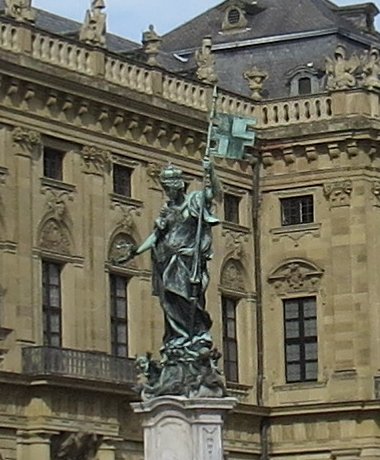
We entered the same way that she did, but we did not immediately approach the White Hall and the staircase. Instead we took a long bathroom break during which I still had the digital recorder on in my pocket.[9]
We finally ascended the stairway. No one could have failed to be impressed by the ceiling that Tiepolo produced. It showed dramatic scenes from four continents—Australia and Antarctica evidently were not considered a continent yet, and the two American continents were treated as one. Each continent was represented by a dominant lady. Katrin pointed them out to us. She also highlighted a few anomalies. Tiepolo knew that ostriches were big birds that could not fly, but evidently he had never seen one. He gave them human legs. The elephant shown in Africa was actually an Asian elephant. More details about the largest ceiling fresco ever can be found here
The Imperial Hall featured (among many other things) Frederick Barbarossa's second marriage, which actually took place in Würzburg in 1156. Here is the way that Katrin told the story: Frederick wanted to get a divorce from his first wife. The pope refused. The Prince-Bishop told the emperor, "Let me do the talking." He then assured the pope that the marriage had never been consummated. The pope promptly annulled it. The grateful Frederick Barbarossa made the Bishop of Würzburg a Prince-Bishop, which gave him more territory, and taxes were paid directly to him. Katrin insinuated that the bishop had lied to the pope, and that Frederick Barbarossa and his first wife, Adelaide, just did not get along.
As usual, in stories that include the phrase "the pope", the facts are more complex. Frederick Barbarossa's first marriage was in 1147, shortly before he joined the disastrous Second Crusade at the order of his uncle, the Holy Roman Emperor. He did not ask Pope Eugene III to annul the marriage until six years later, shortly before the pontiff's death. Evidently the reason offered for the request for annulment was consanguinity.
The man who was Bishop of Würzburg in 1156, when the marriage was finally annulled, was Gebhard Von Henneberg. If he claimed to the pope at the time, Adrian IV, that the marriage was never consummated, he was probably right. They had no children and no known pregnancies. However, Frederick Barbarossa's second marriage produced eleven children, and Adelaide bore seven with her second husband. Neither of them was sterile.
However, Frederick Barbarossa did not elevate von Henneberg to the rank of Prince-Bishop. That honor was not bestowed until 1168, twelve years later, and the bishop at the time was Harold von Hochlein. Oh, well, it might be best not to let an abundance of facts ruin a good story.
Katrin showed us several more rooms, including the Mirror Cabinet, a room that would have driven me crazy if I had to spend much time in it.
I did not explore any of the other rooms in the Residenz Palace, I also did not go into the gift shop. I felt like being outside, and I wanted to take some photos. So, I went to the garden and snapped away.
Katrin provided some more information on the short bus ride to the ship. She pointed out that a ring park surrounded Würzburg where the city's walls used to be. A portion of the old wall could be seen near the gardens of the Residenz Palace.The State of Bavaria currently owned the Residenz Palace with its 360 rooms, many of which were used by the University of Würzburg. There was also a Museum of Antique Art in the building.
The state also owned the wineries that surround the Residenz Palace. The have been operating since 1128 and produce over one million bottles per year. The bottles have a distinctive shape—flat on both sides.
This was a really good excursion. Rothenburg was fun and interesting. The Residenz Palace was spectacular. The bus rides were informative. I have no complaints, and from me that is high praise.After the excursion: I had received a long email from Sue during the day. She had several suggestions about resuscitating my cellphone. At the end she asked me if I was sure that I had the cable plugged into the right slot. This was my reply:
There is only one place to plug. I have tried both permutations. All of my cables are original. I will look for a wireless charger. I would need to turn my phone on to check anything, and the percentage available is now dropping so fast that I am afraid to do so.I then spent some time on the Internet verifying the claim about the Bishop of Würzburg and Frederick Barbarossa's annulment. Then I went to supper.
My notes state that I ate with Mike, Vivienne, and a couple named Paul and Mary. I don't remember much about the occasion, and I wrote nothing more. I am pretty sure that I refrained from asking whatever became of Peter.
After supper Mike, Vivienne, and I went to the lounge to get a good seat for the Live Glassblowing Demonstration that was scheduled to start at 9 p.m. We found ringside seats, and I ordered my second Scotch of the trip.
I had come to watch the glass-blower. In fact, however, it was much more interesting to listen to him. I was very glad that I had brought my recorder.
The presenter's name was Hans Ittig. In his terminology the device that produced the fire was a lamp, and the glass-blowers were lamp-workers. Hans was the seventh-generation practitioner of lamp-working. The industry was brought to Wertheim (pronounced VARE time)in the fifties by a group of East Germans. His whole family had escaped through the barbed wire—his father, grandfather, and grandmother. The East Germans who fled to West Germany were called "economic refugees". Hans was born in 1966 in Wertheim.
Hans's father said that his family left because "The Russians never gave a shit about our industry. That's why we left." The hollow glass (as opposed to solid glass) industry had gone to the West. Corning, the largest glass-maker in the world, set up a plant in Wertheim for "tubing".
In the fifties and sixties the big money was made by the makers of precise measuring sticks such as thermometers that could break 1°C into 500 lines. The workers turned a piece of glass worth $.20 into a measuring stick worth $1,000. So, the locals wanted the refugees to establish a school to teach how to do it. The East Germans were reluctant to do so. They had arrived with nothing and had to live in lousy conditions near the tubing factory. They had left behind factories and beautiful houses, but each of them brought a diamond-plated cutting knife that allowed them to make money from the day that they arrived.
The "real rock and roll" in Wertheim in those days was the neon glass-blowing industry. Those guys made long tubes for holding gas. They were bent into letters and provided with a charge. Wurlitzer's tubes were made in Wertheim. Now most of the neon tubes could only be found in museums.
The #3 profession that was taught at the school in Wertheim was apparatus-building for the chemical industry and other such technical companies. As the only son Hans had no choice but to learn the family's craft. He got his diploma in 1989.
The fourth profession taught at the school was eyeball blowing. The practioners spent eight years at the school and then had to take medical training, but they made a lot of money, and their customers loved them.
The raw materials were called tubes. Each was five feet long; there were five hundred to a box. The first job was to make "points" by closing down the edges so that no dirt could get in. Every glass-blower had a spinning hand and a blowing hand. In the old days asbestos was used to make the materials better, but many glass-blowers died from it. The points were picked off at the end. All the work was done between the points.
Johns Mansville was the largest manufacturer of glass fibers in 2022. The kids knew about them: night-vision, surgical uses, and insulation, too. They even use them for blades for windmills, roller blades, and the like.
Times became tight for people like Hans when in 1990 17 million people from behind the Iron Curtain instantaneously became German citizens. Hans said that every other one was a spy. His family was reunited with his great grandfather Max, who turned 97. For a while there were four generations of glass-blowers in the family. 4 percent of every paycheck was earmarked for helping the East Germans. This made things tough for young Germans, but Hans later became friends with many people from the east.
The problem was the surfeit of East German glass blowers. The companies wanted Hans to make an apparatus for $4.99. If he protested, an East German with ten years of experience would do it for $4.80. He could not compete.
Hans started going to Christmas Markets. He chose Ulm, the city with the world's tallest cathedral.[10] It was also Einstein's home town. Hans gave demonstrations in the wind and the cold. His dad gave him some colors. He was warned not use heavy metals. "You'll kill yourself." The balls that he blew were extremely strong. Having finished one in the demonstration, he rapped it hard on the counter to prove his point. It did not even crack.
In the Christmas Markets he let some of the children help him. A little girl said that she could do it better than he could. To Hans's surprise she blew a perfect ornament. "Told you!" Every kid wanted to blow bubbles, and Hans obliged them without charging them for the resulting ornament.
The problem was that he couldn't make long-lasting loops for hanging. It took him ten years to devise a method. Children blowing their own ornaments became a sensation. The priest at the church was pretty cool. He asked him to do confirmation kits. Hans said that he could do ten a day. At this point Hans mentioned his drum kit and said that he formed a band. However he did not immediately tie that in to the story of the Christmas Markets.
One day the priest brought over a bottle of wine, and the two of them drank it. He wanted to know if they could melt the bottle down. Hans said they would need two hundred bottles. Each year thereafter they produced new glass coins for sale at the market in Ulm. Thirty-five different coins were out there in 2022.
Hans said it this way: "Jesus gave me the (money for) gas, and I became good. I gave him two hours a day." "The tallest church in the world was built by a sparrow." He called the sparrow "my money-maker". From 50,000 visitors when he started the Christmas Markets grew to 2.5 million visitors. He could not keep up with the demand. He found young East Germans to help him. He persuaded them by letting them drive his BMW for one week. They wanted that car, and they signed up to help him.
Hans started selling angels in six-packs. The East Germans made them, and he threw in a free LED. Tens of thousands were sold in one month at one Christmas market. His dad and grandma worked other markets for him. On the ship John, whom he know as a musician, blew a demonstration bubble for him.
He said that he had learned that he should never blow on the same end as the kid; they had spots all over and children diseases! He sometimes warned unruly ones that he would take them home to grandma with her furnace. He told them not to inhale. They could then say, "I did it but I never inhaled it." The even thickness of the shell makes it strong. The kids from the old days were his current customers, and sometimes their kids have kids.
He wanted to be a rock star as a kid, and in 2022 he wanted to be like the guys in America. Dale Chihuly was 77 years old, the same age as his dad. Hans thought of him as a rock star. His dad was invited to teach at Pilchuck Glass School in the state of Washington. His dad went to the Northwest of the U.S.
The Italians never showed the good stuff. In the fifties the Venetians did not become modern. Chihuly was super-active, with schools in Vegas and Eugene, OR. One guy from one of this schools went to Maui. Hans was so happy that he could visit them again.
Hans bragged that he had built a wonderful furnace. It was like a Mercedes. He could not get it approved in America because it lacked earthquake supports, which Hans had never heard of.
Twenty-five years ago Viking called. His mother said that Viking should build a docking place in Wertheim, and they did.
The 4 percent was deducted from their paychecks not for the promised four years, but for twenty years! It was discontinued the same year that the German team became the World Cup champion in Brazil. Everything seemed to them so much better. They had seen what their money had accomplished. It was the "summer dream", especially in Berlin. The East Germans, who could cook like no one else, had made something from nothing.Hans had attended a confirmation the day that he came to the ship. He saw and heard his kid playing music. All of his family played music. He had a classic education on the piano. He summed up the reason for this with an anecdote, which was his style. One of his relatives was fighting the Russians in Ukraine in World War II. He was shot three times in one arm and then spent seven years in a POW camp. He survived because he could play the accordion. He entertained Russians, and eventually they let him come home. If you can entertain, that is enough. It was so much fun for him to see his son play.
The pandemic freaked Hans out. His "gypsy life" had become routine. All of a sudden he was not allowed to travel. He really wanted to go to Maui, where the best glass-blowing in the world was being done.
It was a horrible presentation. It ran more than twenty minutes over the time limit. There was no clear organization that you could "hang your hat on". In fact there did not seem to be any structure at all. No one who watched would have the first idea about how to make a sparrow. He did not even explain the knobs on the torch. If I were still a graduate student teaching Speech 100 at Wayne State, I would have given him a D.
On the contrary, it was a tremendously touching presentation. More structure might have ruined it. I never have felt that I learned as much about Germany, about refugees, and about family in such a short time. I was a curious traveler on vacation, not a graduate student. I gave him an A, and I have always been a tough grader.
I especially liked this segment, which probably should have been the closing:Of course, then he felt the need to add more information about the jewelry his wife had for sale and the tour guides in Wertheim. As Steve Flaman insisted, "ABC: Always Be Closing."
After the demonstration I talked with Mike and Vivienne for a bit. They had the same impression that I had. They had also come to see glass-blowing, but we were all treated to something much more interesting.—the personal experiences of a second-generation refugee from East Germany who, after the reunification, found a way to prod others into integrating into the German nation. It was a real education.I will always remember this day. It ranks very high among all of my experiences traveling abroad.
[1] Würzburg is pronounced VIEWTS burk (without ploding the k) by Germans with a little Elmer Fudd on the r's.
[2] The ignorance of the people in Trier astounded me. Protestants are merely heathens who will burn in hell for all eternity for their stubborn adherence to heretical notions, but the Antichrist is a whole different matter,
[3] The first two syllables are pronounced somewhere between "rotten" and \woten". The third syllable is pronounced burk without voicing the k.
[4] It did not occur to me on the bus, but I later wondered whether the fact that these crusaders had been promised indulgences—sometimes described as forgiveness for all sins—impelled them to judge that they had nothing to lose by taking up a life of crime.
[5] Although Katrin consistently pronounced "village" as "willage" and "vineyard" as "winyard", she had no trouble with "valley".
[6] Everyone in Rothenburg called him Tilly. His real name was Johann Tserclaes, Count of Tilly. As commander of the Catholic League's forces he had a string of victories over the Protestants from 1620-1631, but he met his match in Gustavus Adolphus.
[7] The Residenz Palace was, I think, the only place that we visited on the entire cruise that required masks. The ban on photography upset me at the time, but everything in the palace was so enormous that really good photos would have been difficult. The Residenz Palace's website, which is here, provides a good sampling and detailed history.
[8] I recorded the portion of Katrin's commentary that began when we approached the vineyards outside of Würzburg. I forgot to turn the recorder off before I put it in my pocket when we descended from the bus in front of the Residenz Palace. For the most part the quality of the subsequent recordings is poor, but a few portions were intelligible enough to help me remember points that she made. The question that I asked was very clear, but her answer was not.

